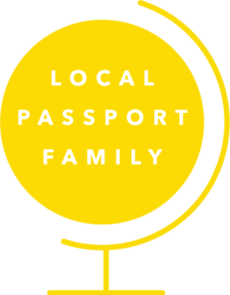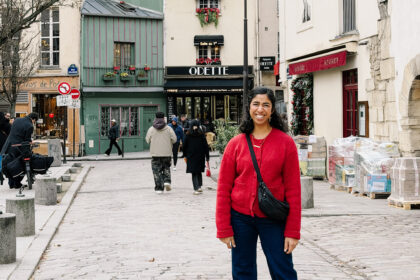We have a family tradition of birthday trips at certain ages. You can read more about this tradition here. Recently I took K to Athens for her 12th birthday. And this year, I got to take T to Japan!
Japan is a fantastic destination for families because there’s an incredible diversity of things to do and most places are quite welcoming to children. Navigating public spaces is very easy with kids and there’s tons to keep them engaged from vending machines to cherry blossoms, as well as plenty of kid-friendly attractions. Public transit is extremely efficient and it’s worth visiting both the larger cities and the countryside.
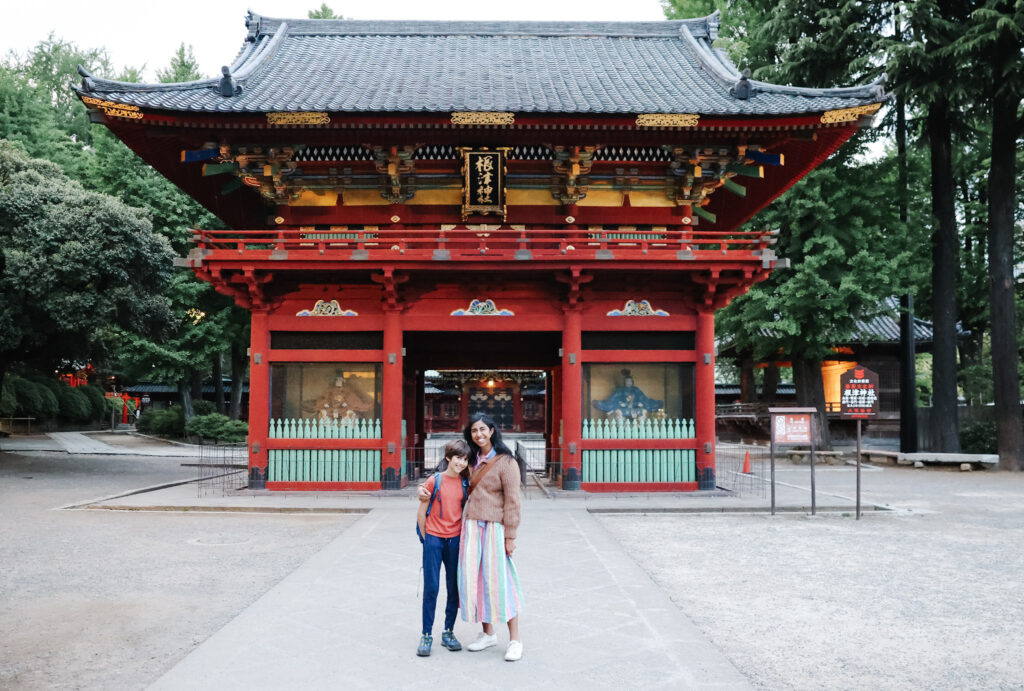
Japan MAP: Best Things To See in Japan With Kids
See THIS MAP to view all the best sites for a family vacation in Japan!

Things to Know When Traveling to Japan
Japan Packing List
I recommend packing layers since the weather can vary—mornings and evenings might be chilly, but afternoons are often mild and pleasant. A light jacket, comfortable shoes for lots of walking, and an umbrella or compact raincoat are smart to bring.
Here are a few things we took along that were especially useful:
- eSim – Since my phone plan didn’t cover Japan, I purchased an eSIM before going that worked out perfectly. Most phone plans cost $7-10 per DAY, which adds up quite a bit, but the plan I purchased through Saily was only $19.99 for 20GB that I could use over 30 days. This was a MASSIVE help and absolutely necessary in Japan – I was constantly using it for things like navigation (I definitely could’ve downloaded Google Maps offline, but then I wouldn’t have had real-time updates for public transport), looking up info about places we were going, figuring out foods, and more. The 20GB over the 8 days we were there was perfect for us – my phone stopped working when I checked something on the train on the way to the airport in Osaka, and I realized that it was because my data had run out. Absolute perfect timing! To purchase, I just bought and loaded it into my phone while I had wifi and it was very easy to activate.
- Rain jacket – couldn’t find my nice Patagonia one so got this one that is affordable and had great reviews and it was EXCELLENT – super waterproof and easy to pack
- Airfly – I absolutely love this little device that allows you to connect your own Bluetooth headphones to the airplane’s entertainment system. You just plug it into the headphone jack, connect, and voila – you can listen via wireless headphones.
- Airplane sleep pillow – I’d heard a lot about these and tried it out this time – it was super helpful!! I tend to be a great plane sleeper in general, but it was SO nice to wake up without my neck hurting, and i think it would be extremely helpful for someone who generally doesn’t sleep well on airplanes
- Credit card – here are the best travel cards for families
- REI Tarn 18 backpack – this is the backpack that T carried on the airplane and was our day bag for going out. It was great! It carried our snacks/water, jackets, passports/money, and camera when not in use
- Folding duffel – we brought a LOT of snacks back for the fam and I was glad to have this duffel packed in the suitcase. I could’ve Tetris-ed everything into the suitcase but this made it way faster and easier. I just threw our clothes packing cubes and jackets in here and called it good. It’s super lightweight and takes very little room (but is also REALLY sturdy, so it’s held up perfectly being checked in many times) so it’s perfect to take along for some extra space.
- Debit card – this is something we forgot and I realized it on the airplane!! I was a little stressed about this as I’d heard that Japan is quite cash-based (which was accurate). I got on the airplane wifi and was messaging with Dan, who looked into options for us. More below!
Best Way To Get Around Japan
The best way to get around Japan is by train—especially the shinkansen (bullet train), which is fast, reliable, and super easy to use even with kids. The rail system is incredibly efficient and connects most major cities and regions. For more local travel within cities, subways and buses are convenient and well-marked. If you’re traveling a lot, the Japan Rail Pass can be a great value and simplifies things with one ticket for multiple routes.
It’s unlikely you’ll need a car in Japan as it’s very easy to get around with trains and public transport, but if you do choose to rent a car, here’s where we usually find the best deals on car rentals:
And here is a complete post about traveling with car seats. These are our favorites by age:
- Favorite Infant Car Seat For Travel Available at: Amazon, Target, Walmart
- Favorite Convertible Car Seat For Travel Available at: Walmart
- Favorite Booster Restrain Vest For Travel Available at: RideSafer
- Favorite Booster Seat For Travel Available at: Amazon
Get Professional Family Photos for Your Trip
We absolutely love using Flytographer to get beautiful family photos; despite having a camera and tripod, there’s something so special about having someone else capture your family in a way that you can’t. It’s a terrific option for getting photos together while traveling (they have photographers all over the world), and we’ve even used them in our home city. Click below to book a session!
Money In Japan
Japan is still quite cash based in a lot of places… which I knew, so you can imagine how stressed and annoyed I was when I realized I forgot my debit card while boarding the plane. I couldn’t believe it!! We’ve gotten so spoiled with using touch pay literally everywhere in London/Europe (even for street performers!). During our flight, I got online to reach out to Dan. He was a superhero with researching all the ways while we were en route.
After we arrived, we tried multiple credit cards for a cash advance at an ATM, which would’ve worked except I didn’t know my pin (probably randomly set up by the card company at some point and obviously I’ve never used it before). I tried to find a physical bank to do a credit card advance but none were open on a holiday weekend Saturday.
We got lucky with some very generous locals and other tourists for our first few stops. One mom paid for our adventure playground entry. And then we were able to transfer money to others in exchange for cash. It worked out great for our first few stops, but definitely not ideal nor a long term solution. So, after visiting Harajuku we headed to Western Union to pick up cash wired from Dan. It was not ideal but it was mostly on our way and didn’t cost extra, so I was really relieved it worked out!
Things To See Japan: One Week Japan Itinerary
We tend to travel at pretty full speed, but I’ll admit some of the days on this trip were a bit exhausting even for us! There is so much to see and do in Japan, it’s hard not to try to squeeze it all in. Just know that you will have an amazing adventure in Japan, regardless of how packed your itinerary is – feel free to slow down and take it all in!
I hope you enjoy this one week Japan itinerary with kids!
Day 1: Tokyo Itinerary
- Flight to Tokyo (Day 0)
- Heiwanomori adventure playground
- Meiji Jingu shrine
- Harajuku
- 7-11 for onigiri
- Imperial Palace
- Itoya stationery store
- Stay at Mimaru Tokyo Hatchobori
We had a 9am flight from London Heathrow direct to Tokyo Haneda. It was a long flight, but so nice to not have layovers or other flights to juggle. We landed at Tokyo Haneda (to STUNNING views from the plane) around 7am. Once we arrived, we used Yamato to send luggage from the airport to our hotel – this was SUPER helpful!! I originally planned to take our luggage with us to the adventure playground, then go drop it off at the hotel. But it would’ve been REALLY cumbersome to take it from the station over to the playground. It also saved us so much time to not need to go over to our hotel in the middle of the day. The service cost about $30 USD to have it delivered same day to our hotel and was VERY worthwhile.
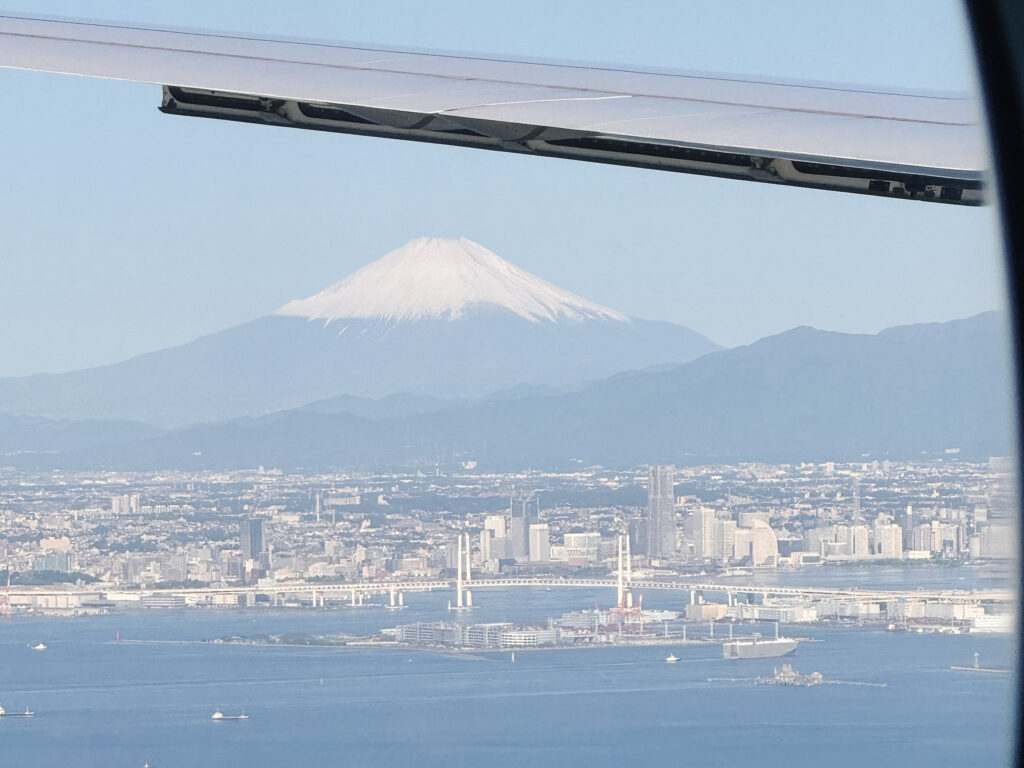
Our first stop was the Heiwanomori adventure playground, which was a perfect place for T (and me) to shake off the jet lag. It’s a big, natural-style play area with climbing structures, wood paths, and places to run and explore. It’s definitely more rugged than a typical playground, which made it feel more like a mini adventure park. There are so many activities – climbing structures, swings, zip lines, boats… basically a giant obstacle course. And you get a little booklet to tick off each activity as you do it. We both loved it and spent a couple hours here but could’ve easily spent longer.
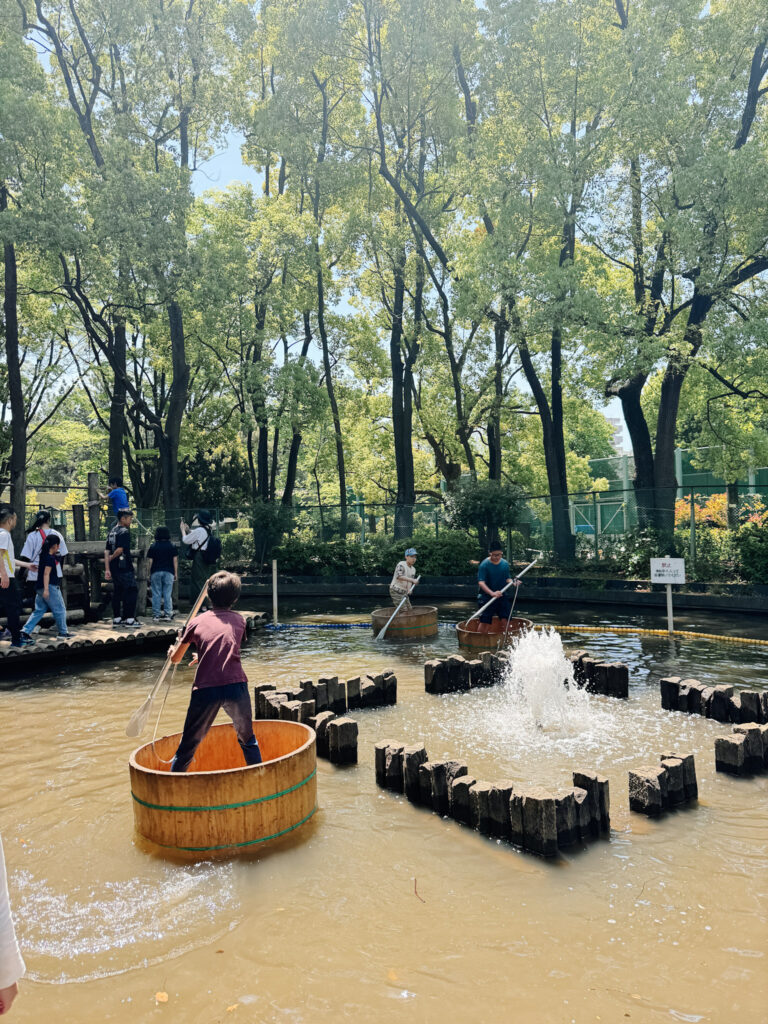
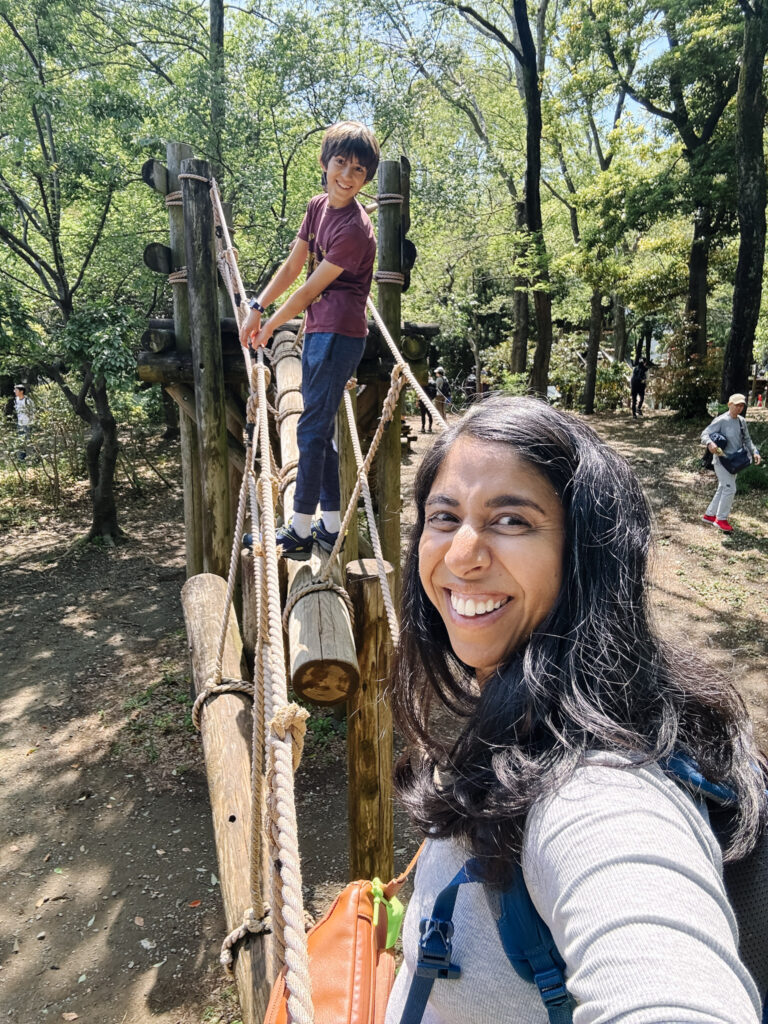
From there, we headed to Meiji Jingu Shrine. It’s in a beautiful forested area right in the busiest part of Tokyo. The walk through the towering torii gates and forested path are so peaceful. It was nice to slow down for a bit, and we even got to see a wedding procession! We also picked up our goshuin book here. Goshuin are calligraphy inscriptions you can get from temples and shrines in Japan. They write them directly in a special book for you (it usually costs 500 yen), although some places (especially if they’re busy) have pre-printed goshuin on papers that you can put inside your book. It’s such a fun and special souvenir and we loved seeing the different unique inscriptions.
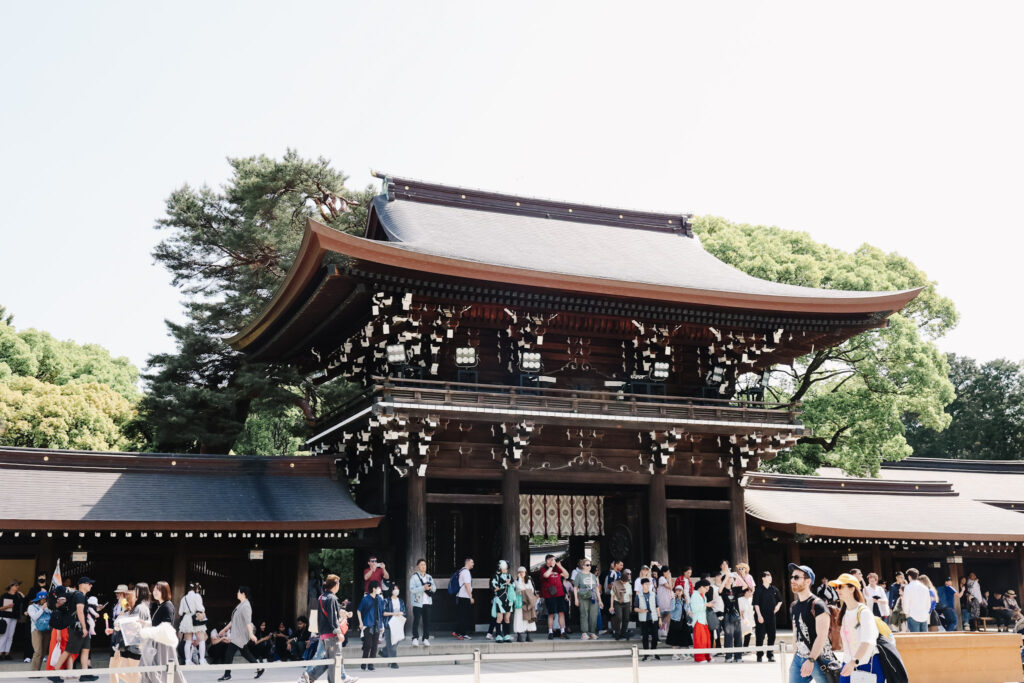
Next up was Harajuku, where we wandered the colorful streets and tried rainbow treats like cotton candy and fun drinks. The energy here is wild—loud music, wild fashion, and tons to look at. It’s a great place to just walk and take it all in, even if you don’t stop in every store. T wanted to try lots of rainbow foods and was especially excited about the rainbow cotton candy! This was a spot that was especially cash-based as very few of the food shops would accept card, but we were able to PayPal a kind German girl we met at 7-11 for some cash. I was super relieved because T had been so looking forward to the rainbow cotton candy and was being a really good sport to say he didn’t need it, but I was glad to be able to get it for him.
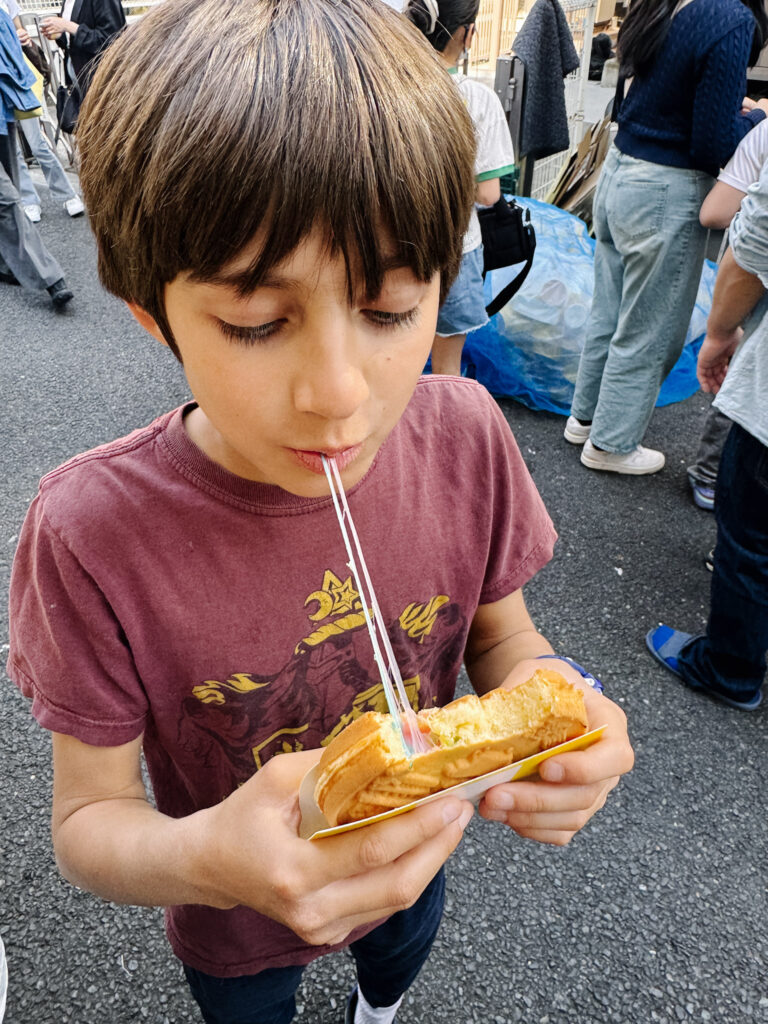
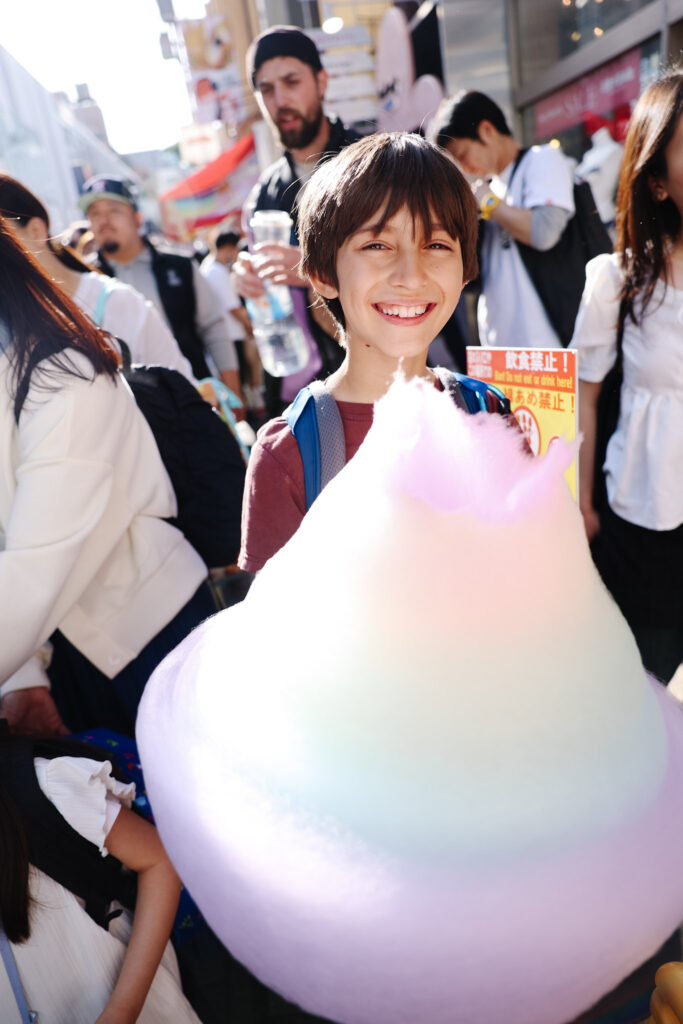
Back to our first day adventures… After Western Union, we grabbed onigiri and snacks from 7-11, which became a favorite go-to throughout the trip—so easy, cheap, and tasty. After a little recharge, we walked around the Imperial Palace grounds. The wide paths and beautiful views made it a peaceful end-of-day stroll, and it was cool to see the contrast between the old stone walls and the modern city skyline. You can also book a walking tour of the Imperial Palace to learn more Japanese history.
Before heading to our hotel, we made a quick stop at Itoya, a famous stationery store in Ginza. It’s several floors of beautiful paper goods, pens, and little art supplies—definitely a fun spot for anyone who loves writing or journaling. It quickly became T’s favorite store and he was so sweet looking for gifts for all his siblings.
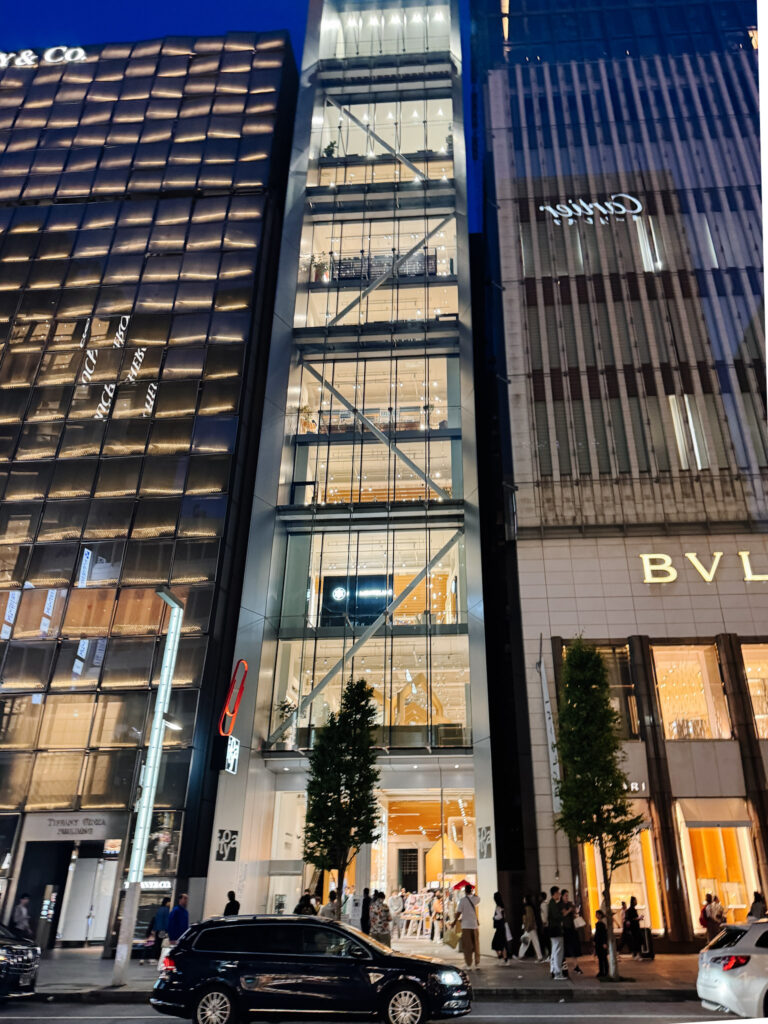
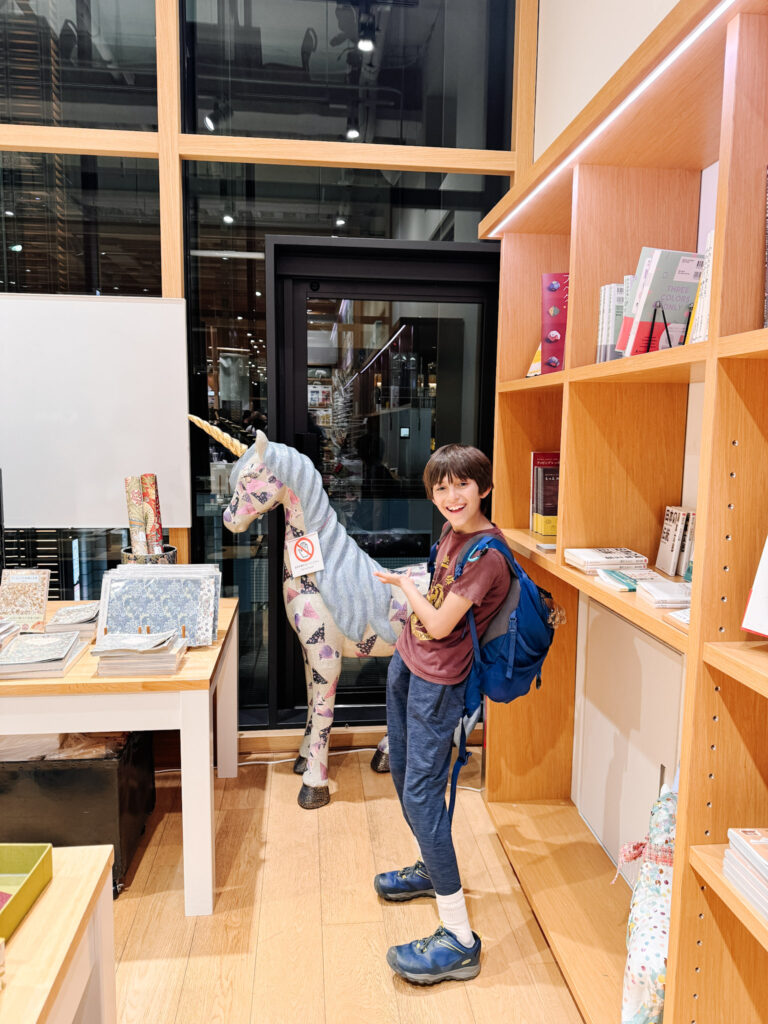
We finally checked into Mimaru Tokyo Hatchobori, which was a great family-friendly spot with plenty of space to stretch out and settle in after a long but exciting first day. We really loved this hotel – it was relatively affordable and spacious (we had way. more space and sleeping spots than we needed for the two of us). We’d absolutely stay there again with the whole family.
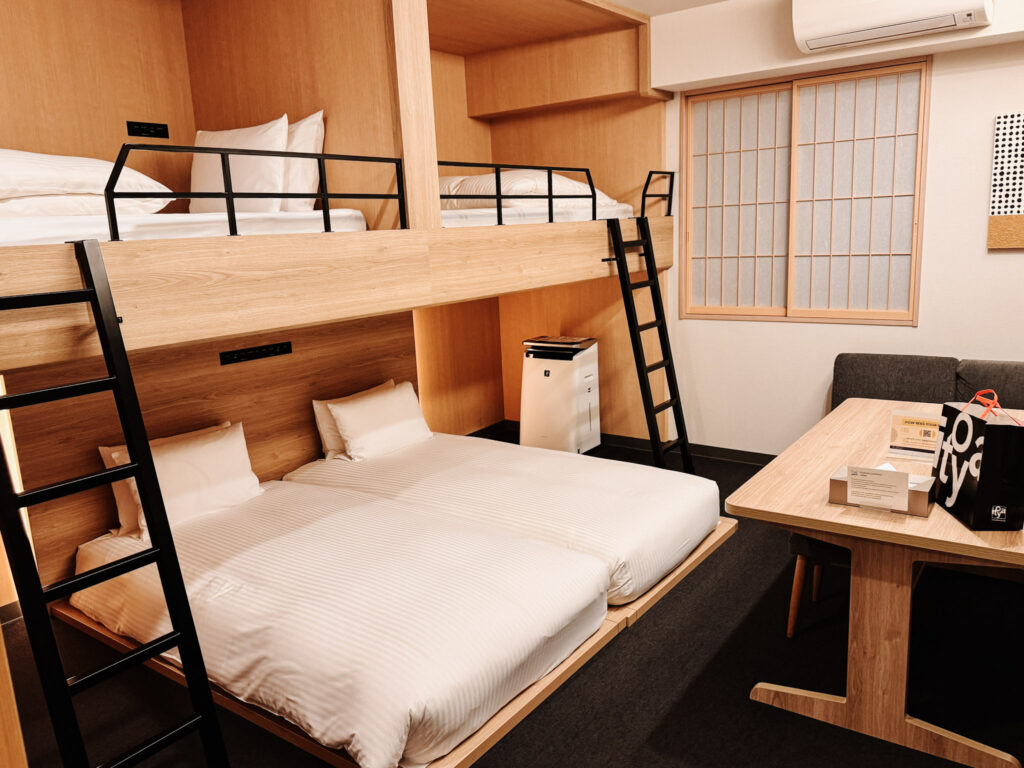
Day 2: Itinerary Tokyo Japan
- Origami in hotel
- Ueno Park
- Tokyo National Museum
- National Museum of Nature & Science
- Ueno children’s book festival
- Toshogu Shrine from afar
- Cooking class
- Nezu Shrine
- Balloon animal making in hotel
- Stay at Mimaru Tokyo Hatchobori
Since we’d had such a busy day the day before (we’d arrived at 7am after an overnight flight and didn’t go to bed until past 9pm!), we slept in a bit the next morning. T was definitely still tired but I finally woke him around 9:30 so we could get going. This was the most jet lag we had the whole trip – it worked well for us to push through that first day and immediately switch over to the new time zone. On our way out of the hotel, we made origami koinobori (carp streamers) in honor of Children’s Day. It was a lovely, hands-on way to connect with the local culture, and a nice, slow-paced way to ease into the day. I loved that the hotel had this available for families! They also had little prizes for the kids. Seriously such a great Tokyo hotel for families.
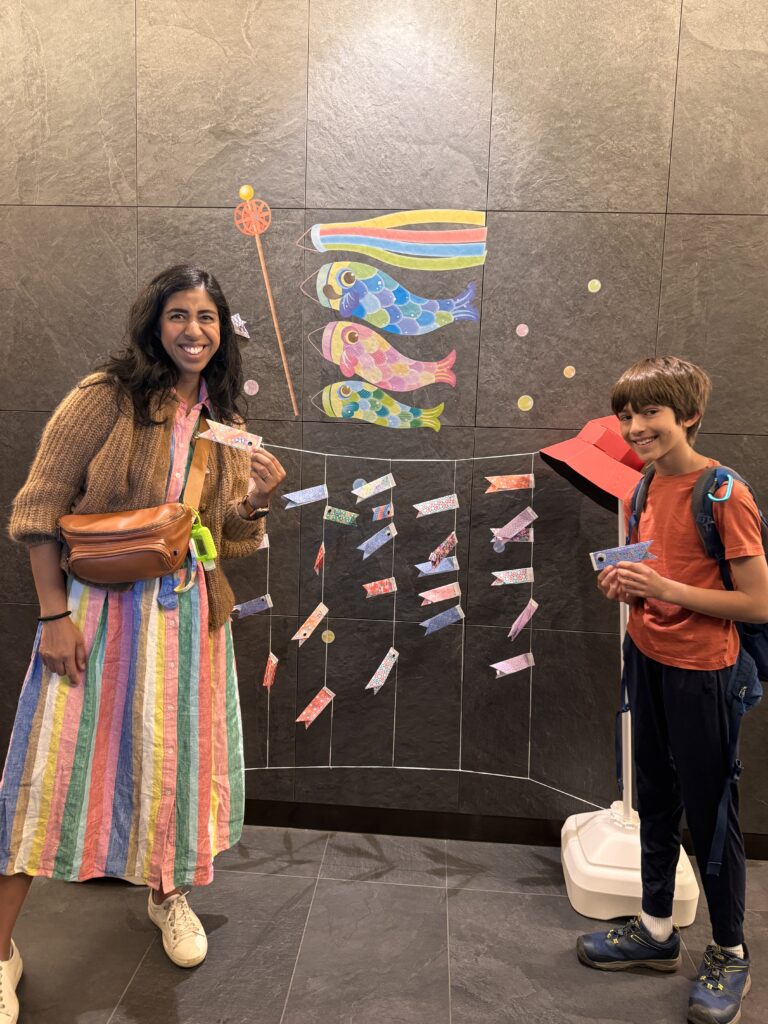
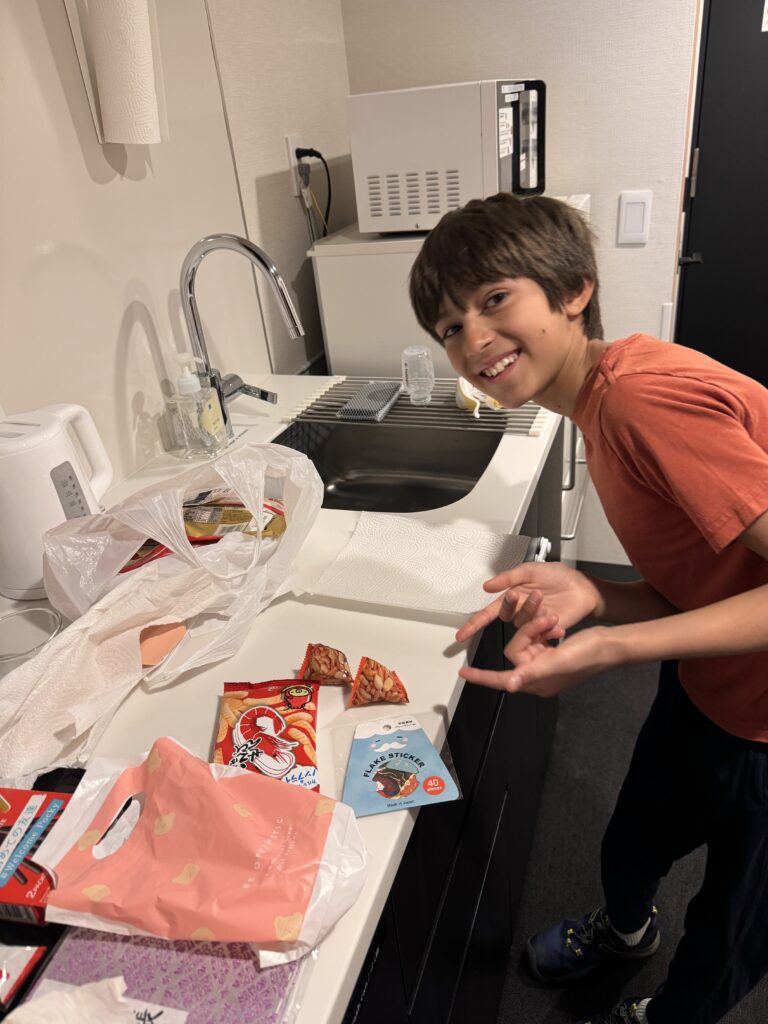
Next, we headed to Ueno Park, which is huge and full of energy. It was extra busy for the holiday weekend, so we enjoyed some yogurts and people watching. There are lots of food stalls and just an overall playful energy. The park is also home to several museums, so it made a great place to start the day.
We made our way to the Tokyo National Museum. The exhibits are beautiful and thoughtfully presented, with ancient artifacts, samurai armor, and traditional art that gave us a great intro to Japanese history. We especially loved the swords, ceramics, kimonos, and ancient Buddhist temple relics. This place is HUGE! We really loved it and wished we had more time to explore.

Right nearby is the National Museum of Nature & Science. Then it was onto the Museum of Science and Nature. T absolutely adores animals so it was fun to go with him. I don’t know that I’d necessarily choose it on a Tokyo trip otherwise – there’s so much to do here and I’ve been to many better natural history museums. This one felt a bit dated. If you’re short on time in Tokyo, I’d skip this stop.
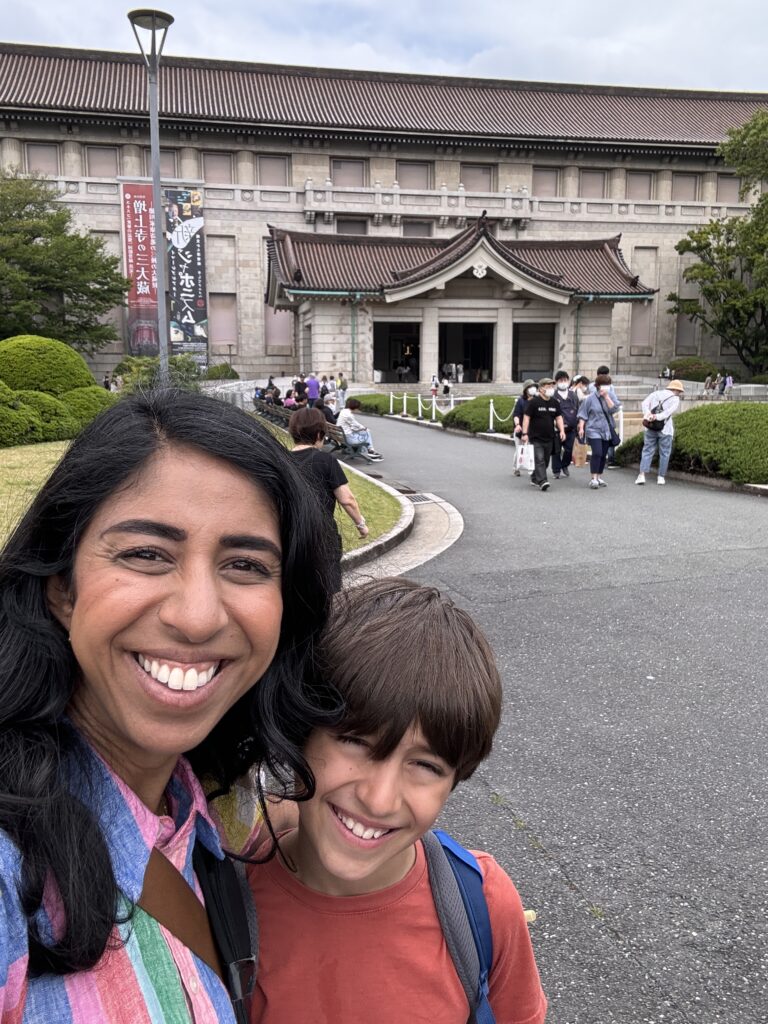
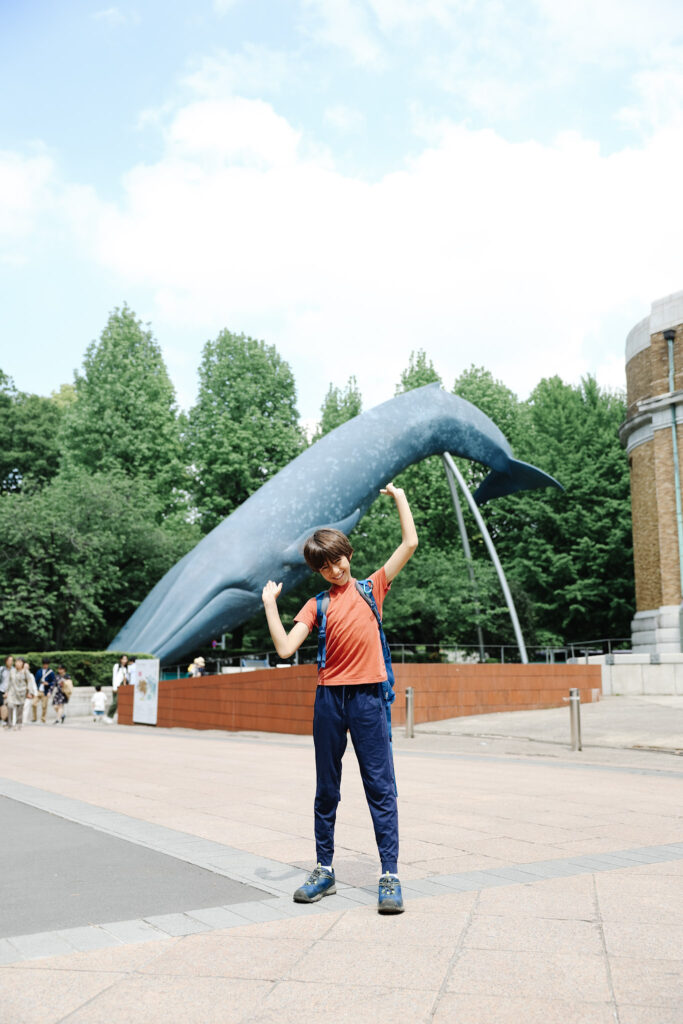
After leaving the museum, we stumbled upon the Ueno Children’s Book Festival in the park, which was such a fun surprise. It was so fun to explore and T could have stayed the whole day!
On our way to our cooking class, we caught a glimpse of Toshogu Shrine from afar while walking through the park. It looked beautiful nestled among the trees. After that, we took the subway over to our cooking class! We had both been eagerly awaiting this activity and it did not disappoint. We met at a chef’s home and he walked us through how to make both vegetarian gyoza and ramen, and then we finished with a tea ceremony. He was really kind to accommodate us with vegetarian fillings, as well as a vegetarian base for the dashi (soup) for the ramen, which is not very common. It was all super delicious! We didn’t hand make the ramen noodles or the gyoza wrappers, but we did everything else by hand and it was so fun. We each even had our own little burner to boil noodles and prepare our ramen. It was just the two of us in the chef’s home (plus an interpreter, since the chef didn’t speak English) and it was so lovely. Everything was absolutely delicious and we loved ending with the tea ceremony to learn how it is prepared. We found our class on this website, but there are also several different classes here and here.
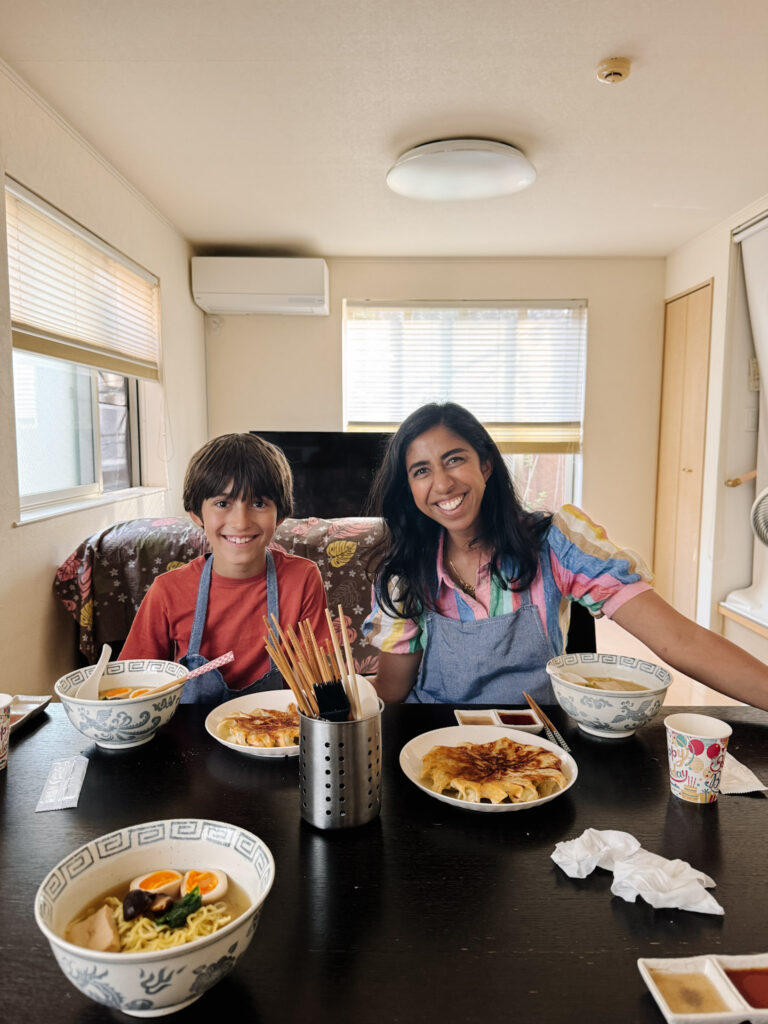
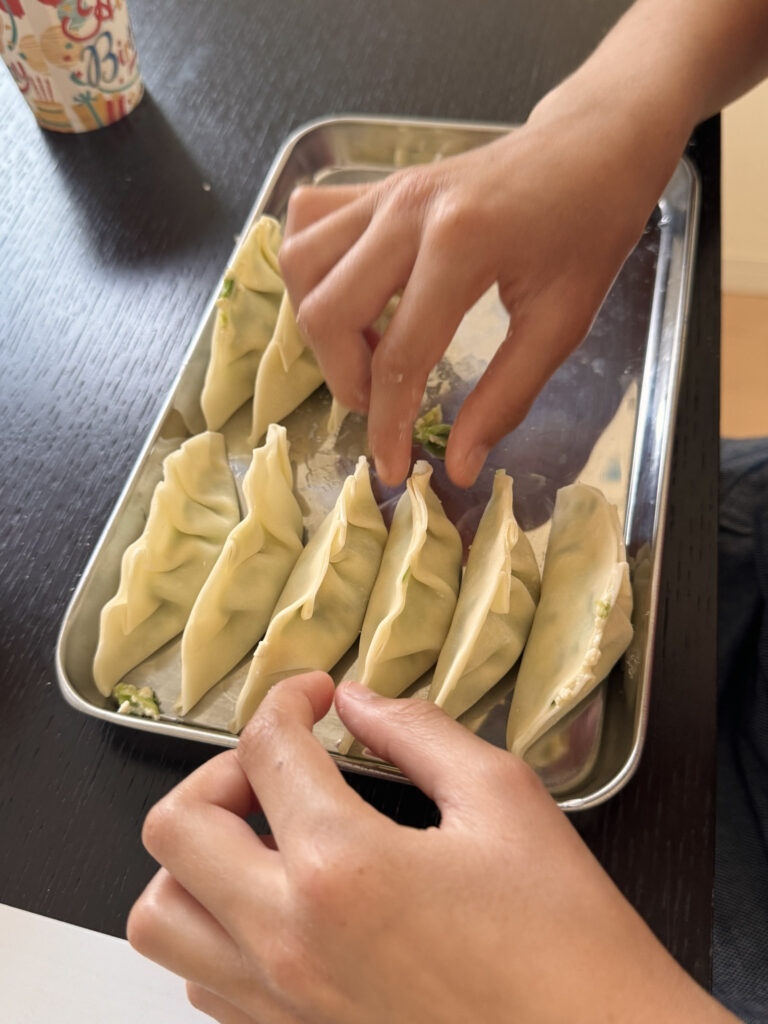
To end the day, we visited Nezu Shrine, a quieter and less touristy spot. It is so beautiful and I’m so glad we were able to get in just before it closed. T was so happy to get a goshuin (special calligraphy you can collect at different temples and shrines). The shrine also has beautiful torii gates, which was really lovely – especially because it was the end of the day and we had them all to ourselves!
Back at the hotel we did some balloon animal making before bed. We loved all the activities they offered! It was a super busy day, but it was so lovely and fun all around.
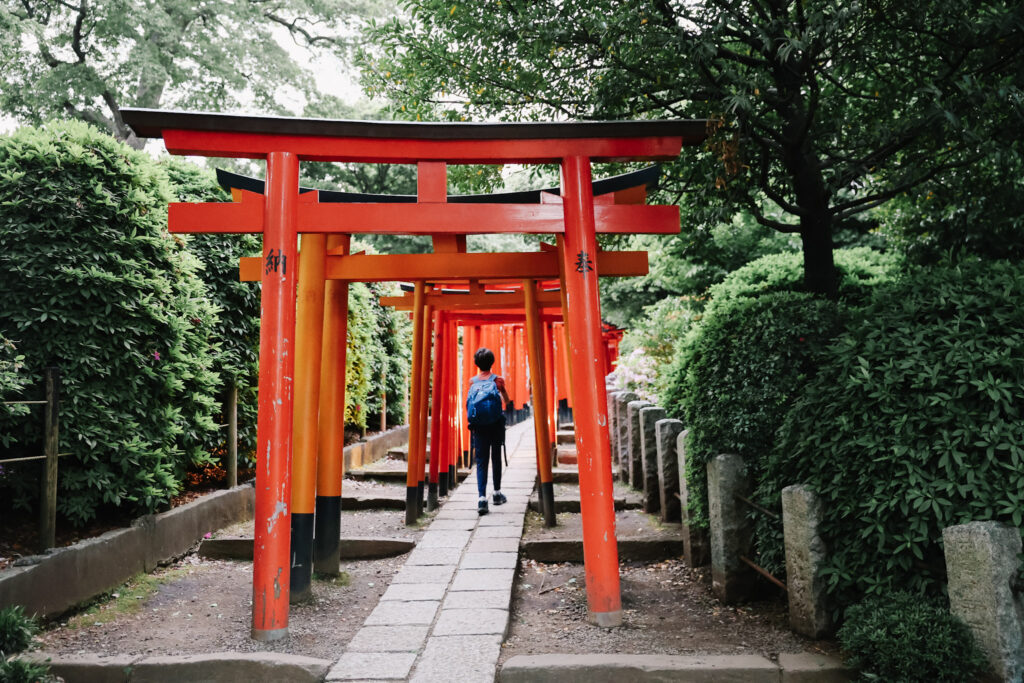
Day 3: Tokyo Travel Itinerary
- Sumo stables practice/tour
- Hokusai Museum
- Asakusa – Senso-ji Temple & Nakamise street snacks
- Tsukiji fish market
- TeamLab Planets – dinner there then exploring the exhibits
- Stay at Mimaru Tokyo Hatchobori
We got up bright and early to see some sumo! It was really special to be able to go to the practice area and watch morning practice. Our tour guide was fantastic. We were taken to a competition ring after practice and learned tons of info about the history and nuances of sumo. Our guide was a former sumo sports writer so he was incredibly knowledgeable. It was super fascinating, albeit a little long. We ended up watching for about 2.5 hours.
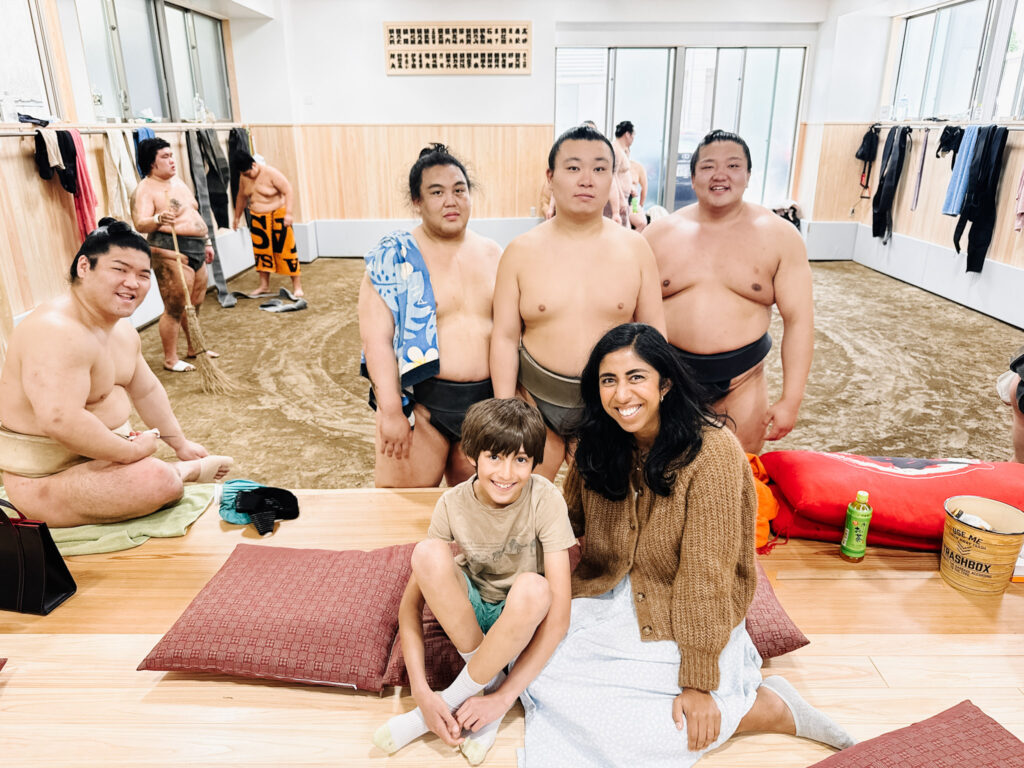
From there, we headed over to the Hokusai Museum, which celebrates the famous ukiyo-e artist best known for “The Great Wave.” T has been a big Hokusai fan for years, so I loved being able to encourage that. The museum itself is modern and well-designed, with exhibits that trace his life and show a wide variety of his work. We had a lovely picnic out front in the sunshine and enjoyed some red bean mochi.
From there, we made a quick stop for sushi and then headed to Senso-ji Temple in Asakusa. We made a stop here when T was just a toddler, so it was fun to return. The long Nakamise shopping street leading up to the temple is full of snacks, souvenirs, and tiny shops selling everything from sweets to quirky toys. The temple itself is colorful and lively, and it’s a fun place to experience the buzz of Tokyo’s more traditional side.
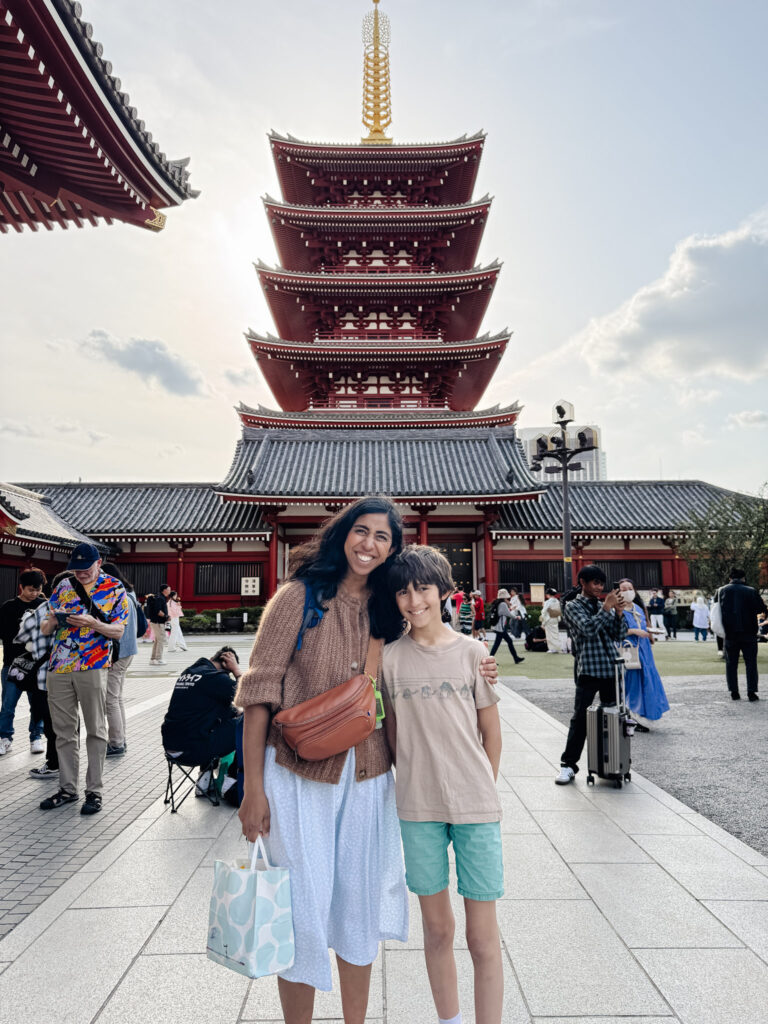
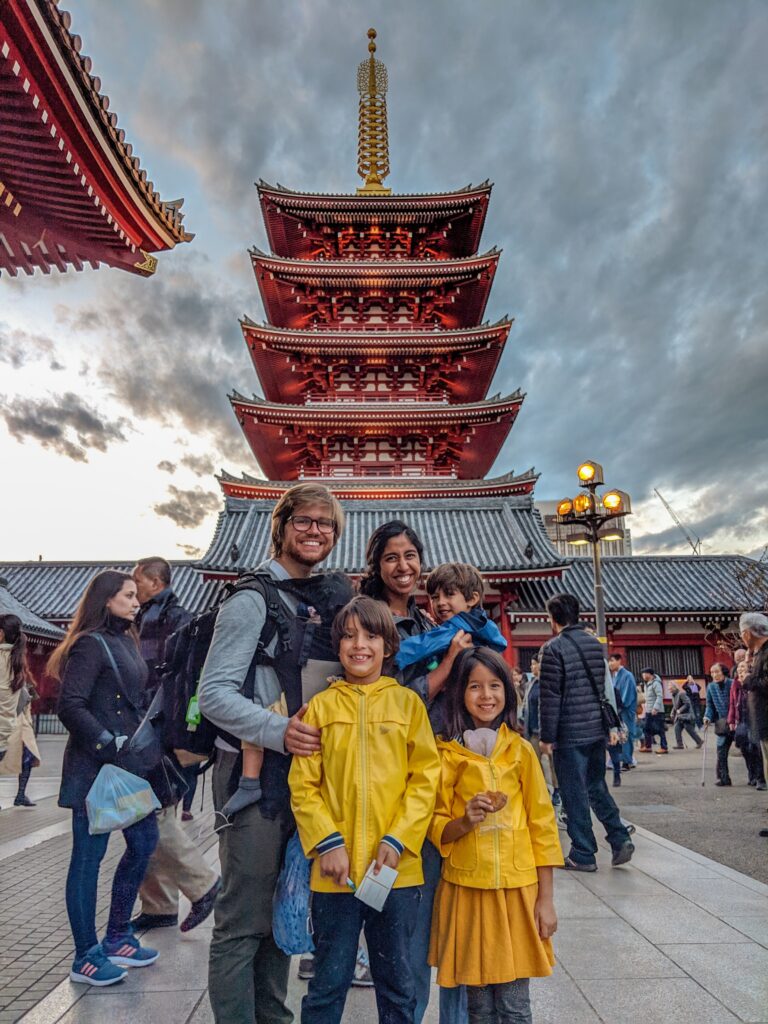
We had hoped to stop by Tsukiji Fish Market afterward, but by the time we were done in Asakusa, it was already closed—something to keep in mind since many stalls pack up earlier in the afternoon. Still, we didn’t feel like we missed out too much, since there had been plenty of great street food around the temple area. If you have time, book a Tsukiji Fish Market Food and Walking Tour.
For our last stop of the day, we headed to TeamLab Planets, a totally immersive digital art experience that was incredible! Before exploring the exhibits, we grabbed ramen and more red bean mochi. For the exhibits, I spent a long time debating between Borderless and Planets. We went with planets and I’m so glad we did. The exhibits are so engaging and entertaining and beautiful. Walking barefoot through water, lights, and mirrors was incredibly fun and surreal. This place gets a lot of hype and it can be hard to get tickets, but, overall, I think it was well worth it. A great ending to a high-energy day!
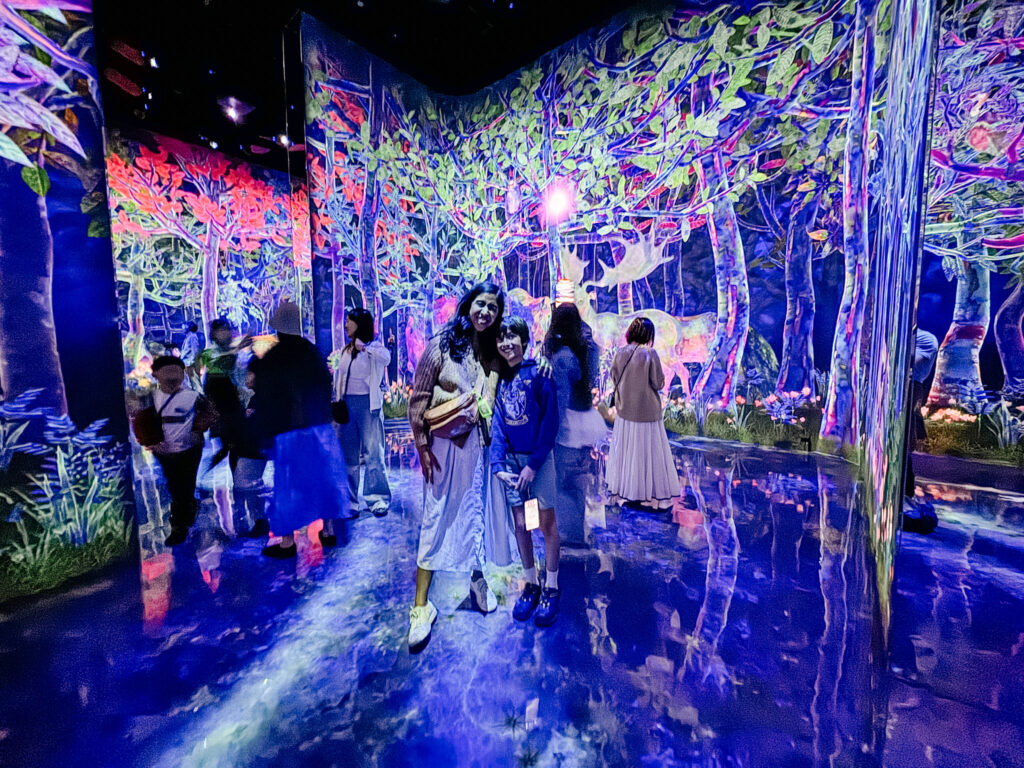
Day 4: Itinerary Kyoto
- Bullet train to Kyoto
- Bus to Monkey Park
- Tenryu-ji Temple
- Arashiyama Bamboo Forest
- Supermarket
- Samurai & Ninja Museum
- Nishiki Market for snacks
- Udon for dinner
- Yasaka Shrine
- Stay at Hyatt Place Kyoto
We started the day with a quick taxi ride to the train station since it was raining, and then hopped on the bullet train to Kyoto. The shinkansen is such a smooth, fast way to travel, and even in the rain, the scenery out the window was lovely. Once we arrived, we dropped our luggage at Hyatt Place Kyoto to lighten the load before heading out to explore. The hotel was super convenient – a quick metro ride from the main train station, and attached to the metro stop by a covered walkway (which we appreciated since it was pouring rain this morning). (Side note: we were very happy to have seen Mount Fuji from the airplane since there was no hope of seeing it from the train, even though we’d booked seats on the right side of the train. But it’s worth booking that side just in case!)
By the time we’d dropped our luggage and eaten a bit of food, it had pretty much stopped raining (and didn’t rain again the rest of the day!), so we hopped on the #93 city bus over to the Monkey park in Arashiyama. The journey takes a bit of time (it’s definitely not in the center of the city), but is straightforward. It took about 45 minutes to get to the entrance, and then another 15 or so minutes to walk to the top where all the monkeys are. It’s a beautiful walk with lots of greenery, but is uphill and does take a bit of time, which we didn’t realize, so do plan for that. That said, the views and the monkeys were totally worth it! T loved watching the monkeys roam freely, and there was the cutest little baby that he (and I) was obsessed with. You can feed the monkeys inside the house only, and only with the food that you purchase from them. It also gave us a great view over Kyoto despite the gray skies.
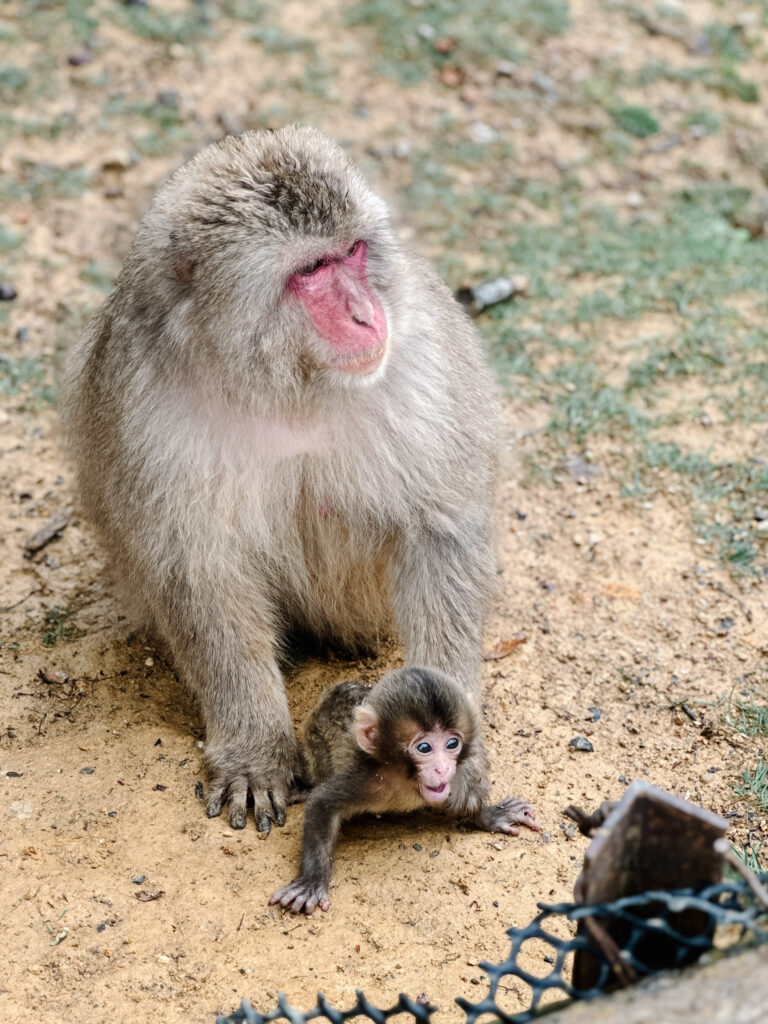
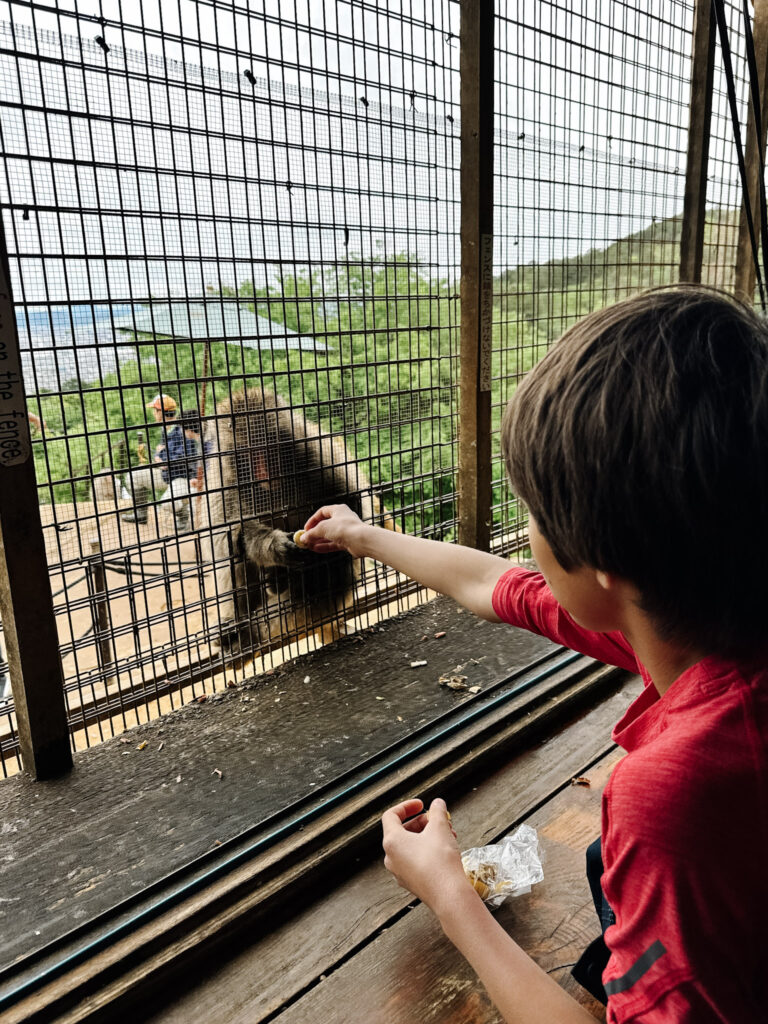
Next, we walked about 20 minutes back down the path over to Tenryu-ji Temple, which is absolutely beautiful. We didn’t pay to go in the gardens because we were short on time, but they looked lovely from the outside. Just a short walk away, we wandered through the Arashiyama Bamboo Forest. We hadn’t originally planned to stop here because it can be quite crowded, but I’m so glad we did. It’s beautiful! It was definitely crowded, but still lovely to walk part of the way. You can also access the bamboo forest from the temple gardens, but you do then need to pay to access the gardens. Otherwise, the bamboo forest is free to visit if you enter from the main road (the same road as the main entrance to the temple, just a little further down). After, we grabbed some snacks, including some round doughnuts and a fish-shaped red bean paste- filled treat. We’d been hoping to find one of these as they’re supposedly good luck, especially on Children’s Day, so we were excited to try it – it was delish!
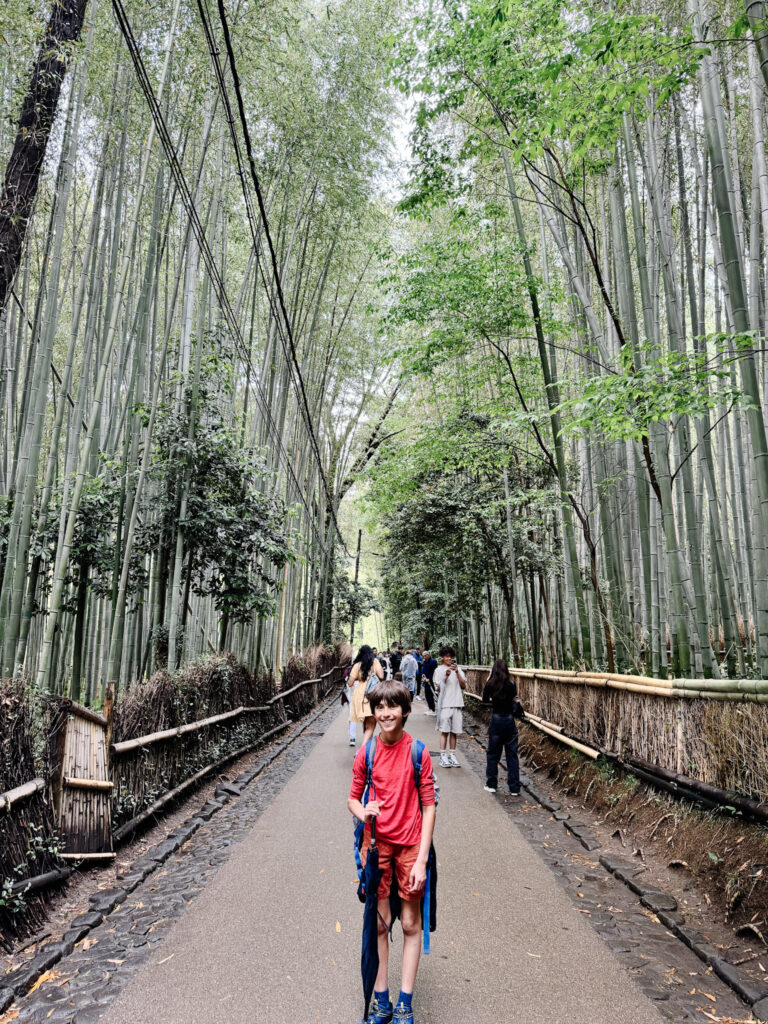
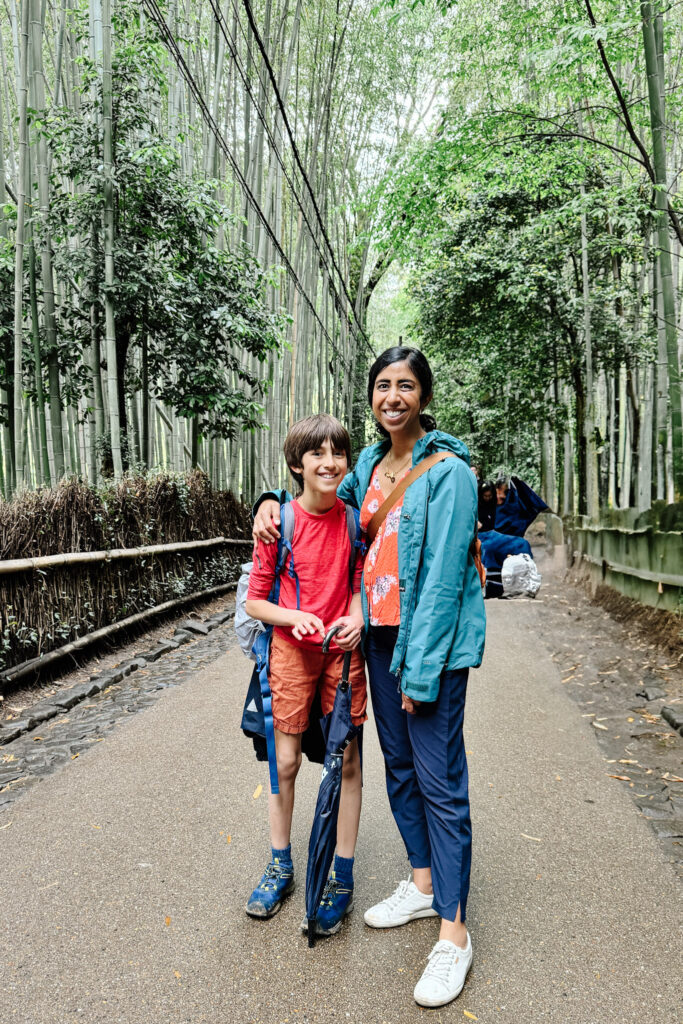
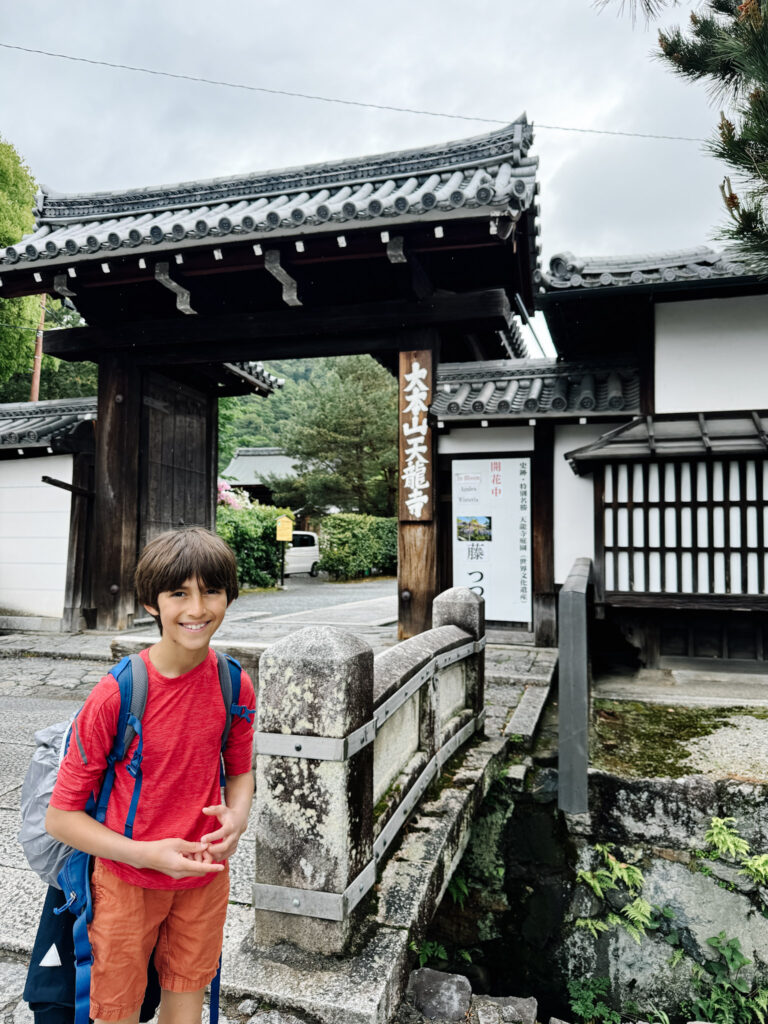
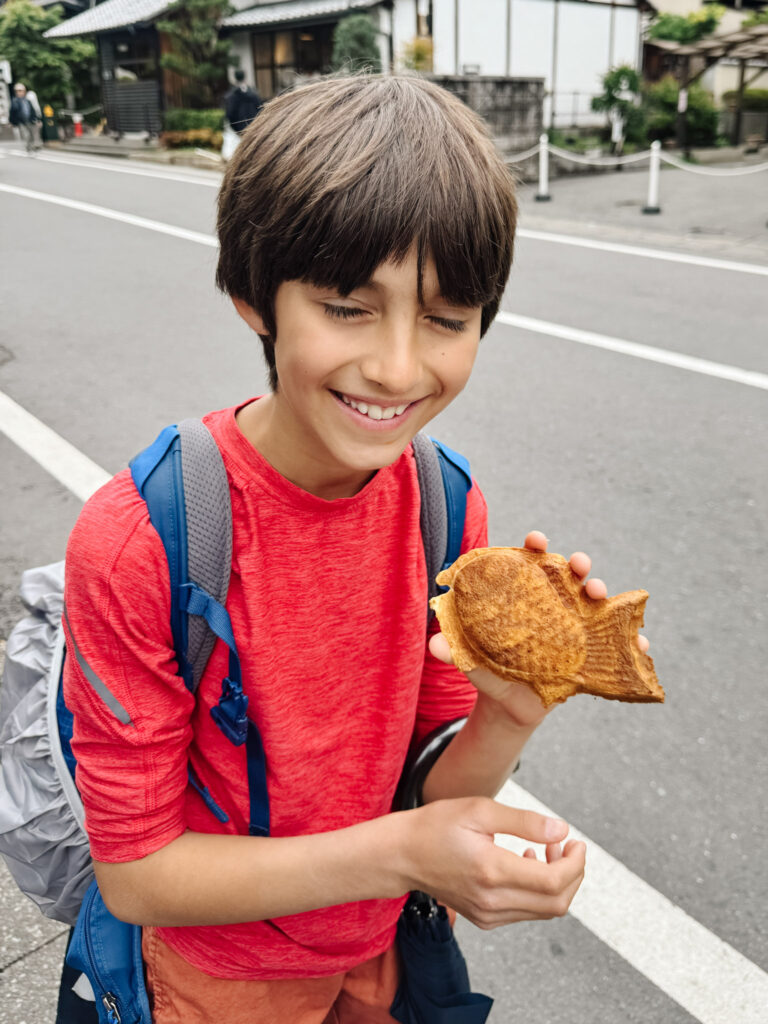
After that, we took the city bus back over to Nijo Castle, which we’d hoped to visit. Sadly, the final ticket sale was earlier than we realized so we weren’t able to go inside. Instead, we took a quick stop at a local supermarket to explore and pick up a few small gifts and snacks to bring back home with us. It’s always fun seeing what’s different in the aisles and finding cute packaging or unexpected flavors and we found some lovely items here. The supermarket actually had a couple shops above it (all open to the same interior, but with multiple checkout tills), where we found a fantastic Japanese Santoku knife for me (which I’d been wanting to bring home), as well as some lovely Japanese-made ceramics that were a fraction of the cost of tourist markets. There are lots of places like this, I’m sure, but this big one that we found was about a 5 minute walk north of Nijo Castle.
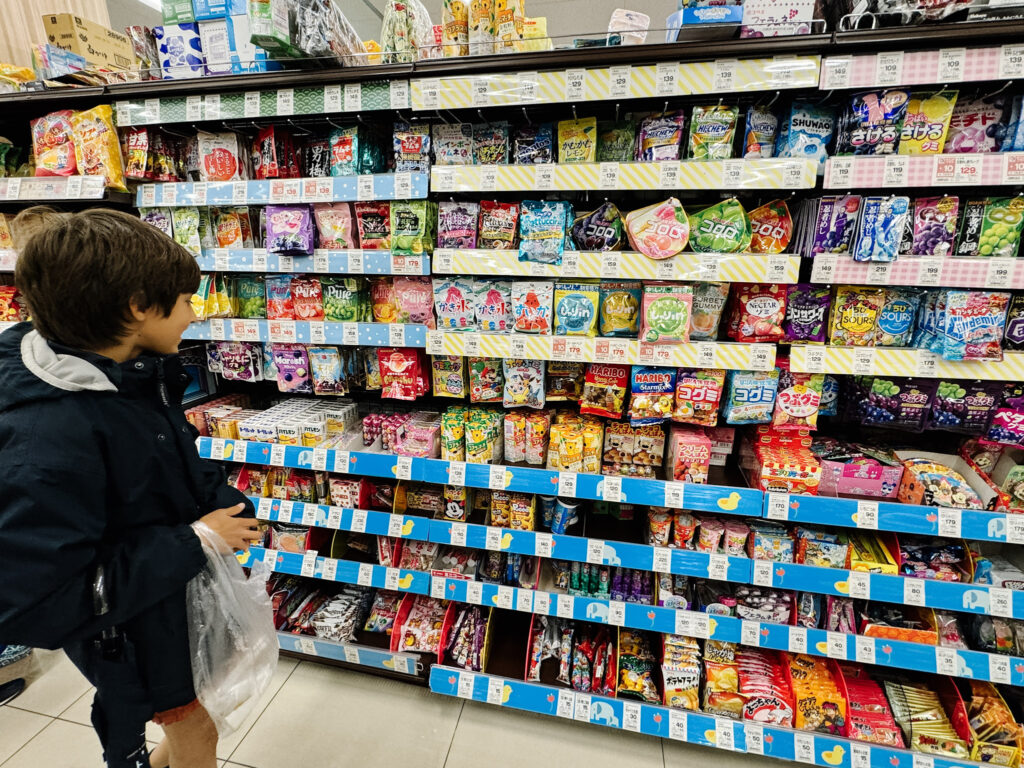
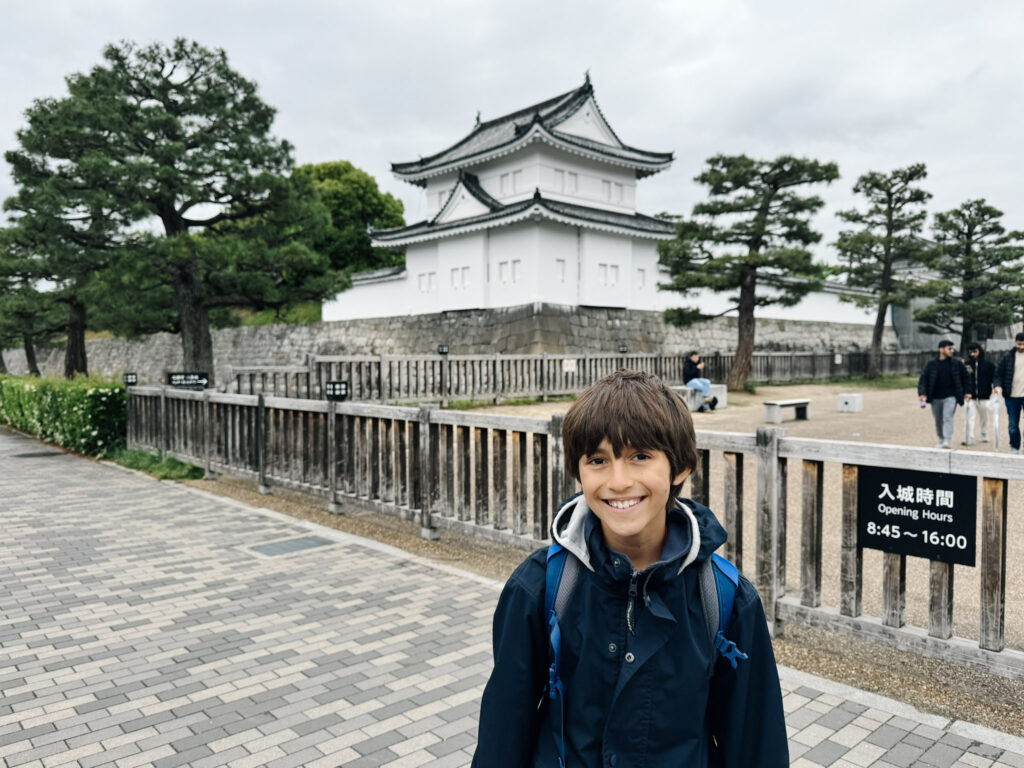
Then we headed to the Samurai & Ninja Museum to learn some more Japanese history. Though this was high on our list, I was a bit worried it would be a little gimmicky, but we both ended up being super impressed! A tour guide takes each group through and explains different phases of Japanese history and I feel like we learned a TON. T commented multiple times on how much he enjoyed learning about it and how funny our guide was! He really was excellent and shared so much knowledge and was extremely patient with my many history nerd questions after the tour ended.
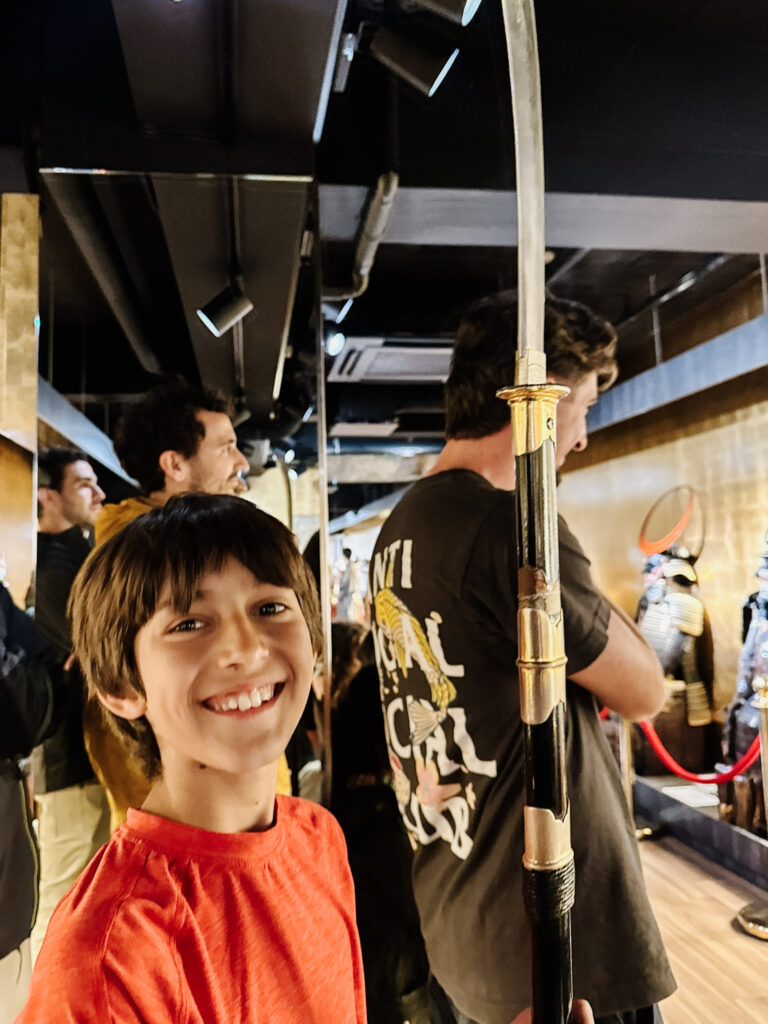
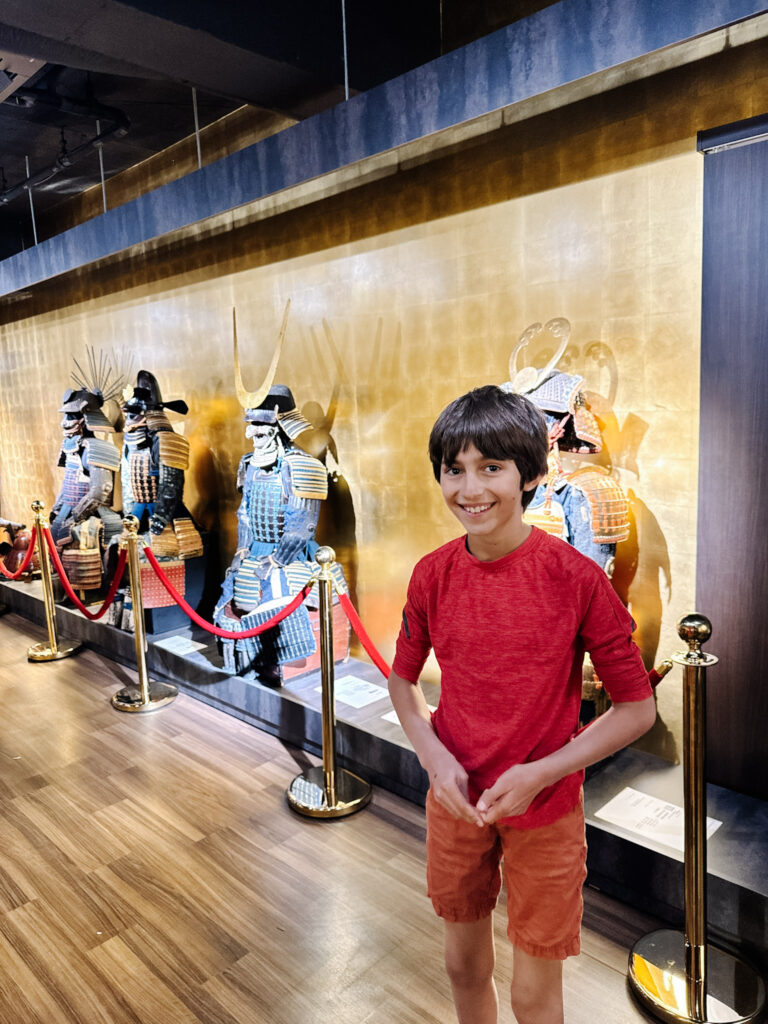
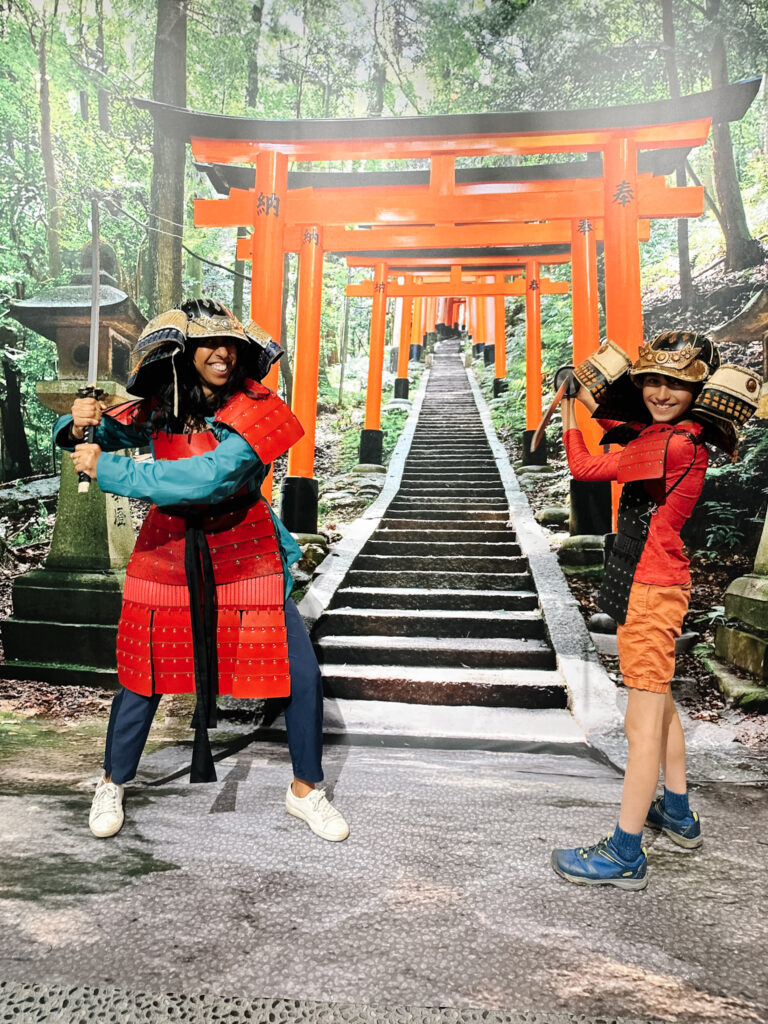
To end our day, we strolled through Nishiki Market to sample a few snacks—there’s so much to try, and it’s a great place to grab little things to share. If you really love food sampling, book this Nishiki Market Tour. Afterward, we took a bus to Gion to get udon from a place that serves a vegetarian version, but we missed their last order by just a few minutes. Luckily, we found another nearby spot for a cozy dinner instead.
We wrapped up the day at Yasaka Shrine, which looked magical all lit up at night. It was peaceful and quiet by that time, with a few people still lingering. Although we couldn’t get a goshuin (temple stamp) that late, it was still a beautiful way to end an exhausting day.
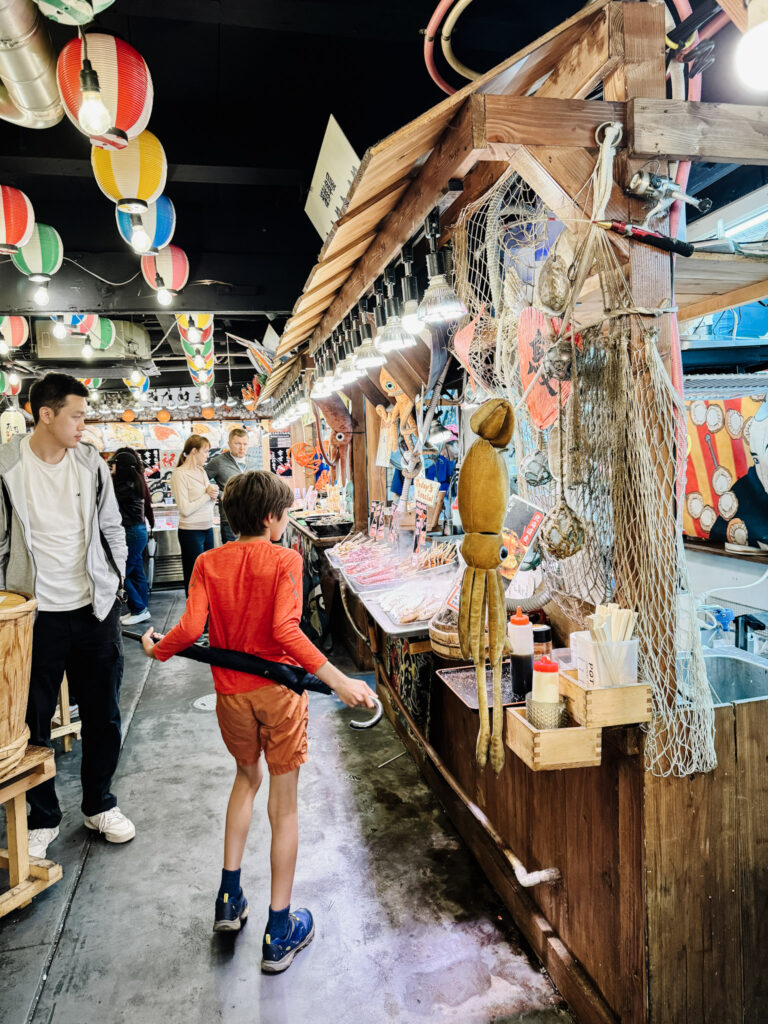
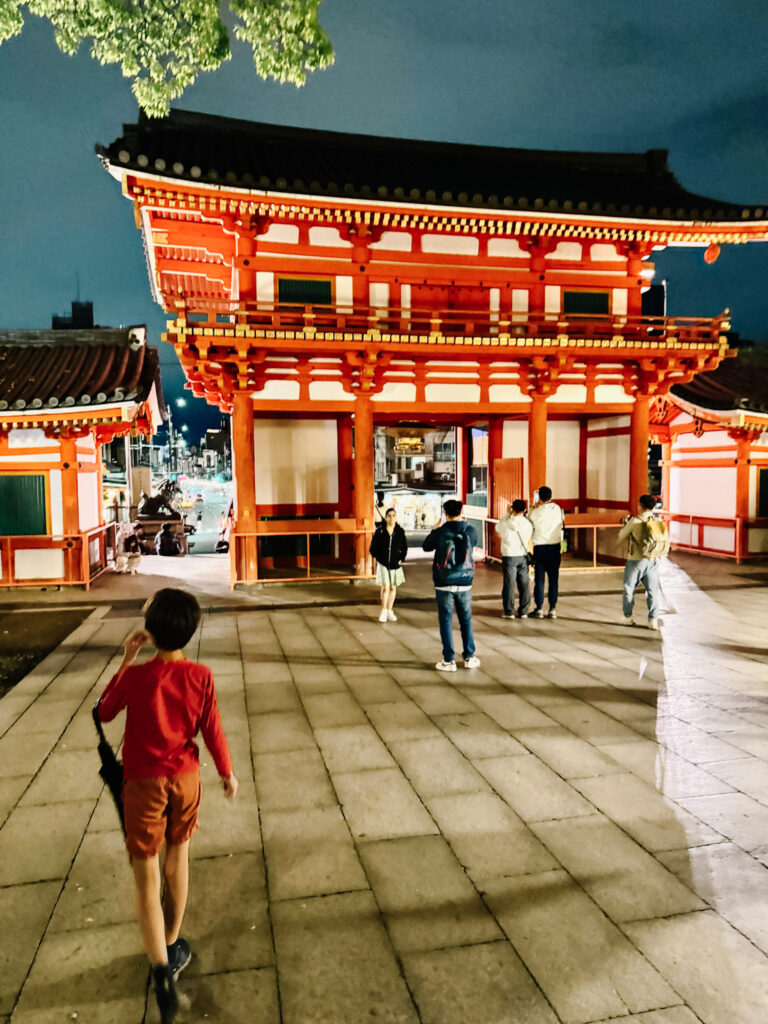
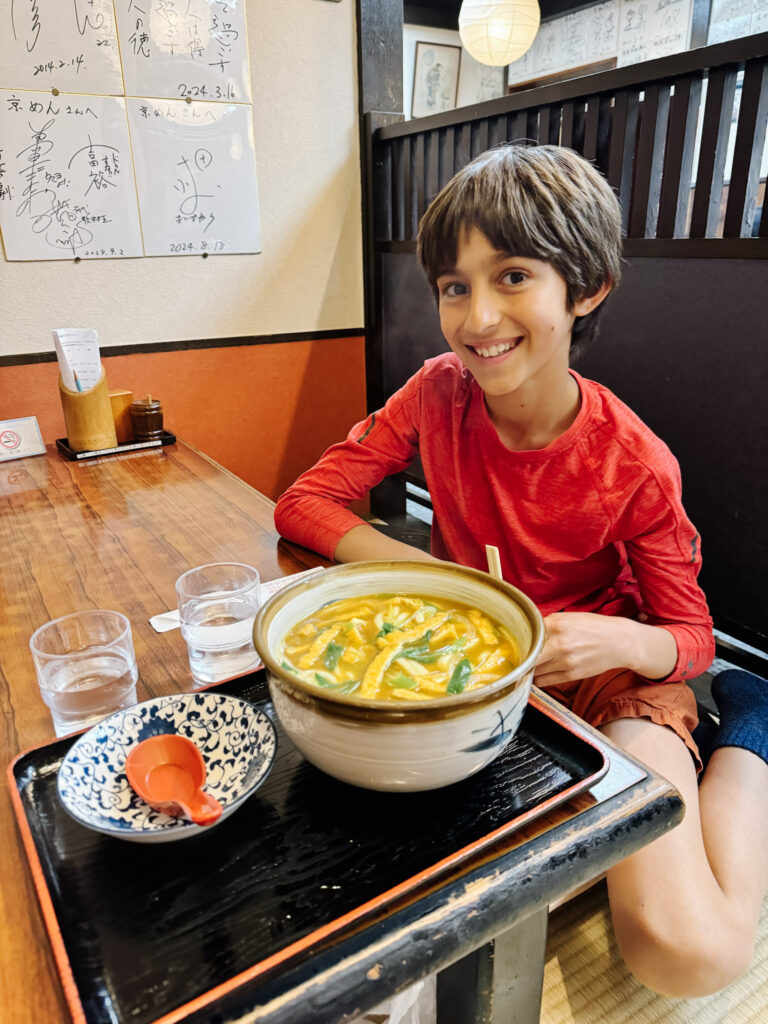
Day 5: Things to Do in Hiroshima
- Hiroshima Peace Park & Museum
- Miyajima Island
- See deer
- Torii Gate
- Play on beach
- Ropeway to Shishiwa Observatory
- Traditional Crafts Center
- Back to Kyoto and Hyatt Place Kyoto
We started the day in Hiroshima with a visit to the Peace Park and Museum, which was incredibly moving. We started out by taking the Shinkansen to Hiroshima, and then the tram from Hiroshima Station to Genbaku Dome one one edge of the Peace Park, which took about half an hour. The dome was hit almost directly by the atomic bomb but was the only building to survive there, and is now left as a memorial. It was definitely sobering to arrive to, and felt in very sharp contrast with the beautiful sunshine. We then spent some time walking around the Peace Park, looking at the children’s memorial (heartbreaking) and some other memorials and spots.
We then finished up by visiting the Hiroshima Peace Memorial Museum. The exhibits are powerful, offering a thoughtful look at the impact of the atomic bomb, but also pretty horrifying to see the affects – both immediate and long-term. While it did have some hopeful messages about peace, it was definitely a very heavy museum and morning. T had specifically requested to visit Hiroshima since he’s been very into reading about World War II lately, and it felt okay – though still pretty gut-wrenching – to take a 10 year old there, but I probably wouldn’t advise the museum for younger kids. If you do choose to take them, I’d recommend going through pretty quickly to not dwell on the horrifying images, or take it in turns with another adult. That said, it did feel like a very important place to visit and had me really thinking through a lot of current and past decisions, so I would really recommend it for older audiences.
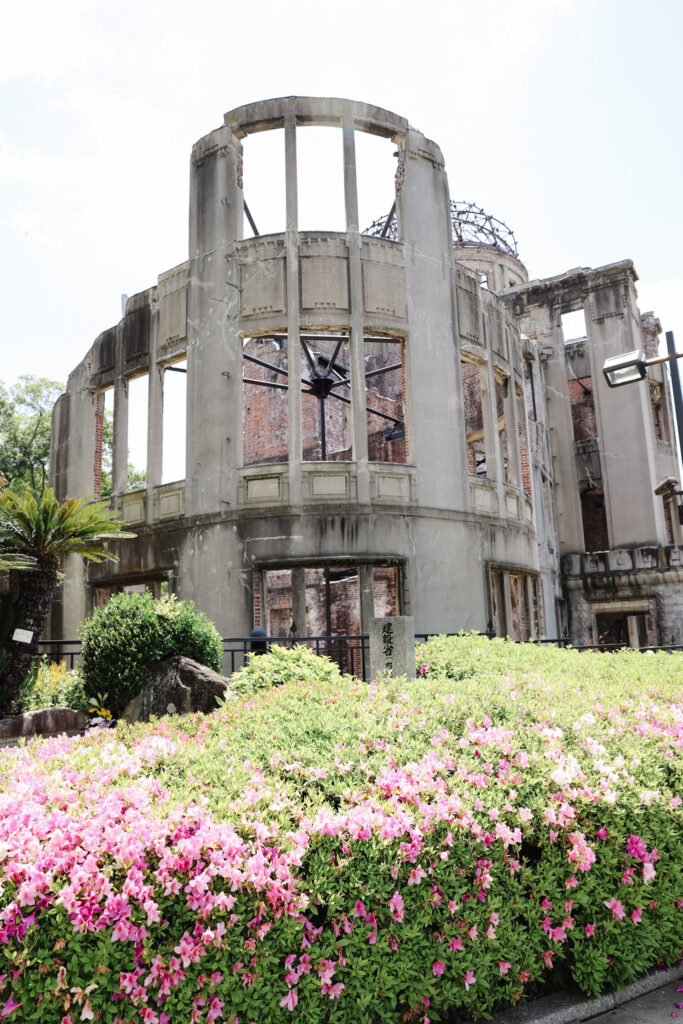

After our time in the museum, we took a bit of time to sit outside in the sunshine and eat some snacks and regroup a bit. We had packed along some onigiri from 7-11 and were glad to have some easy sustenance with us. From there, we made our way to Miyajima Island. There is actually a private ferry that goes directly from the Peace Park to Miyajima Island, but it’s quite a bit more expensive – it would’ve cost 2,200 yen (adult) + 1,100 yen (child) (about $23 USD) vs the tram to Miyajimaguchi Station for 240/120 yen + the ferry for 200/100 yen, for a total of 440 for an adult and 220 for a child. If the direct ferry were significantly faster, I think I would’ve been fine with it, but the one that was about to leave was full, which meant we’d need to wait there another half an hour, which meant we’d arrive at the same time as we would by taking the tram and the local ferry. We didn’t feel like we needed to pay 2640 yen MORE to arrive at the exact same time. The tram and ferry worked out perfectly and we loved the approach with the view of the torii gate in the water.
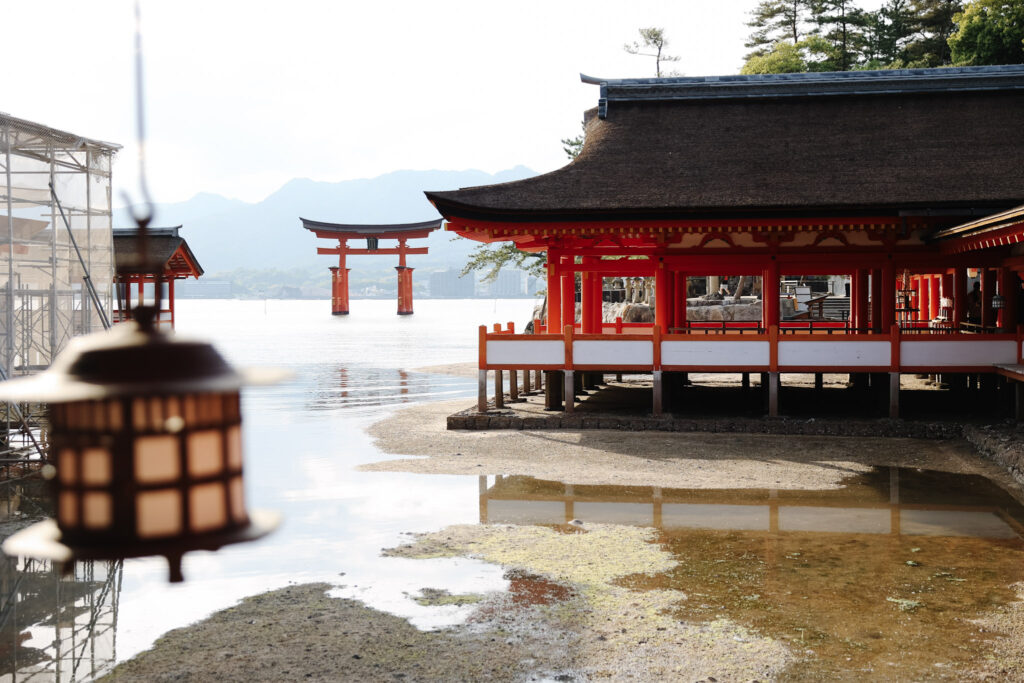
Arriving on Miyajima Island felt like a complete shift in mood—relaxed, green, and full of curious deer wandering the streets. T loved getting up close to the deer (while keeping snacks safely tucked away!), and the atmosphere on the island was chill and welcoming. We had hoped to visit the Traditional Crafts Center earlier in the day, but unfortunately, it was closed that day. So instead, we walked to the famous Torii Gate, which sits out in the water and looks like it’s floating during high tide. It’s such an iconic sight and even more beautiful in person. While the gate was in the water, the tide was low enough that there was plenty of beach to sit and play and relax while T explored every tiny crab and other sea creature.
After spending some time on the beach, we walked up the hill to catch a quick (free) shuttle to take the ropeway (cable car) up to the Shishiwa Observatory. The ride itself was fun and absolutely beautiful, and the views at the top were stunning—green hills, distant islands, and a clear look back across the water. We spent a few minutes at the top (you actually take two separate cable cars to get up there) and then headed back down on one of the last cars. The shuttle had stopped by the time we arrived back, but we just walked the 15 or so minutes down the path back to town (it would’ve taken longer up).
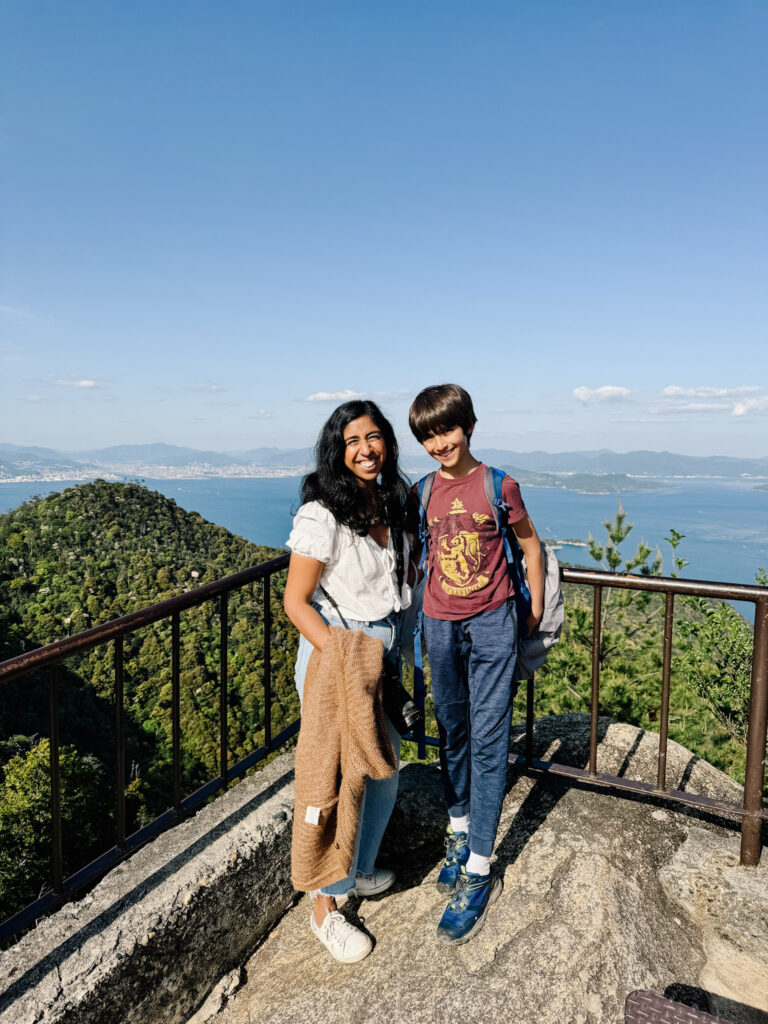
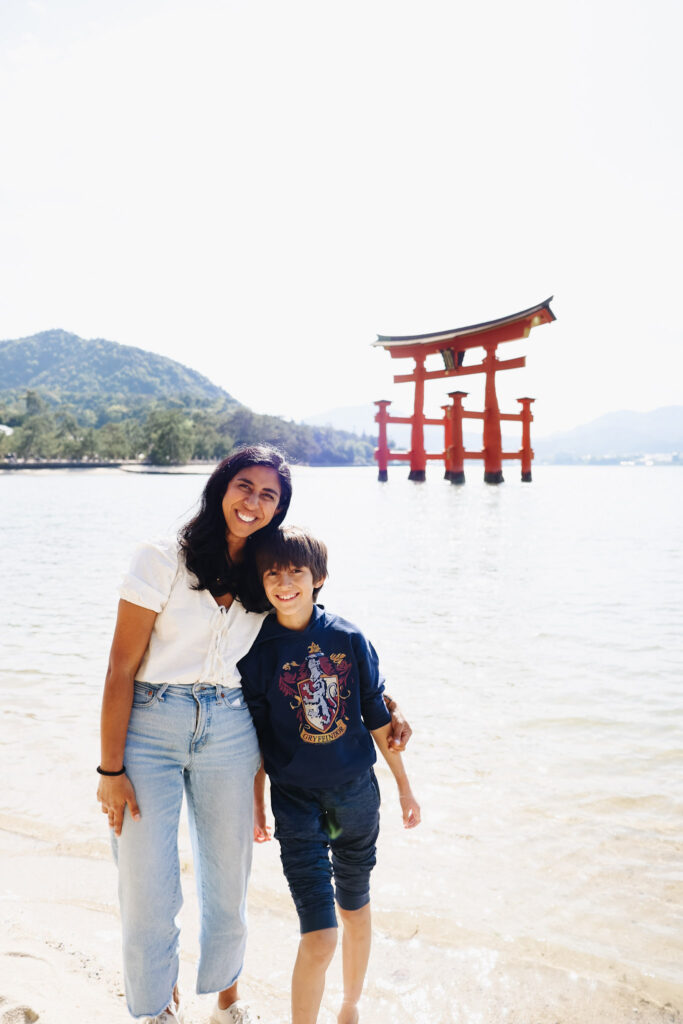
When we arrived back down, we headed into the Itsukushima Shrine, the one to which the Torii gate in the water belongs. Not many people had recommended actually going in, but we loved this one! It’s a beautiful view out on the water (which was at high tide by this point, and had completely submerged the area under the temple), and it was beautiful walking inside (and we loved getting a goshuin there). We took some photos, admired the stunningly setting sun out on the water from the beach, and headed back to the ferry, the metro, and then back to the bullet train back to Kyoto, where we just about fell into bed!
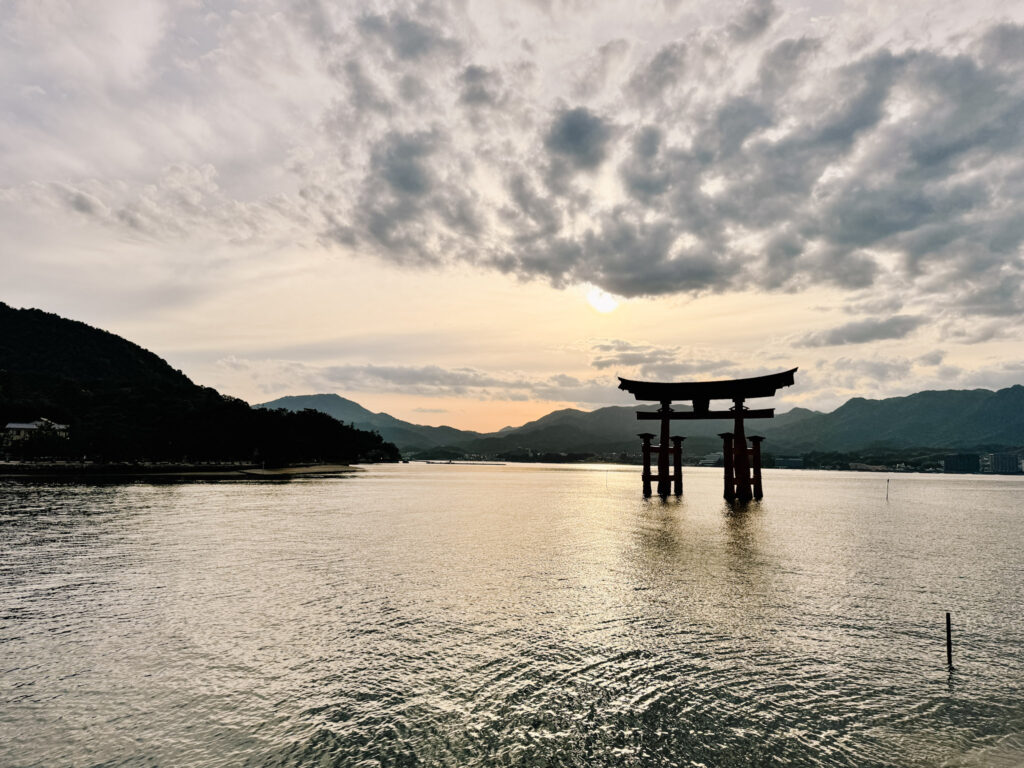
Day 6: Kyoto Travel Itinerary
- Check out & ship luggage
- Fushimi Inari Shrine
- Kiyomizu-dera temple
- Kyoto Gyoen National Garden
- Nijo Castle
- Travel to ryokan
- Dinner & onsen at ryokan
This morning, we checked out of the Hyatt and had them send our luggage to the Kansai Airport. Yamato (the same service we used before and the one our hotel used) recommends 2-3 days for airport delivery, which worked fine for us. We knew we’d be staying at a ryokan this night, and then traveling far away to stay at a monastery the following night, so we were very happy to not drag our suitcase (and all the snacks and treats we were bringing home) along with us.
Then we headed to Fushimi Inari Shrine, one of Kyoto’s most iconic spots with its long tunnels of red torii gates. It was definitely busy near the entrance – we intended to get here early this morning, but decided to rest a bit more after our very full day and late night the night before. And it was fine! Crowded but still beautiful. Plus, as we climbed higher, the crowds thinned out and it became much more peaceful. We loved walking through rows upon rows of the gates. We didn’t get near the top (I hear it take a few hours to do the whole thing) due to time, but I’d love to go back and walk the whole thing someday. On the way down, we veered off to a small bamboo grove tucked near the path, which made for a quiet little detour. This would be a great option if you’re not heading out to the Arashiyama bamboo forest. More details about how to find the bamboo grove here.
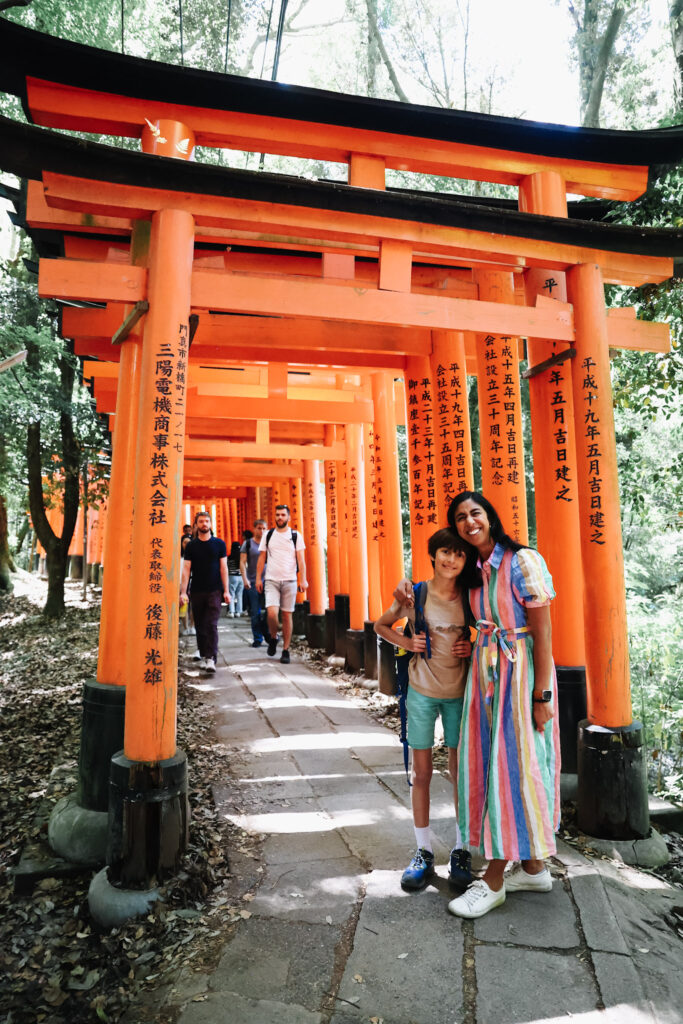
Next, we took the bus over to Kiyomizu-dera Temple, which has some really impressive wooden architecture. It’s a fun place to explore, with winding paths and lots of little nooks and shops to peek into. We loved exploring a bit in this area – we got some delicious milky soft serve and a chilled cucumber on a stick – both of which hit the spot on a hot and sunny day. We loved wandering the streets with the shrine in the distance! Once we got to the top, we entered the shrine to visit the inside, which was beautiful, and of course we got our goshuin. This was an extremely crowded area, but still really fun to visit, and it was even more beautiful than I anticipated.
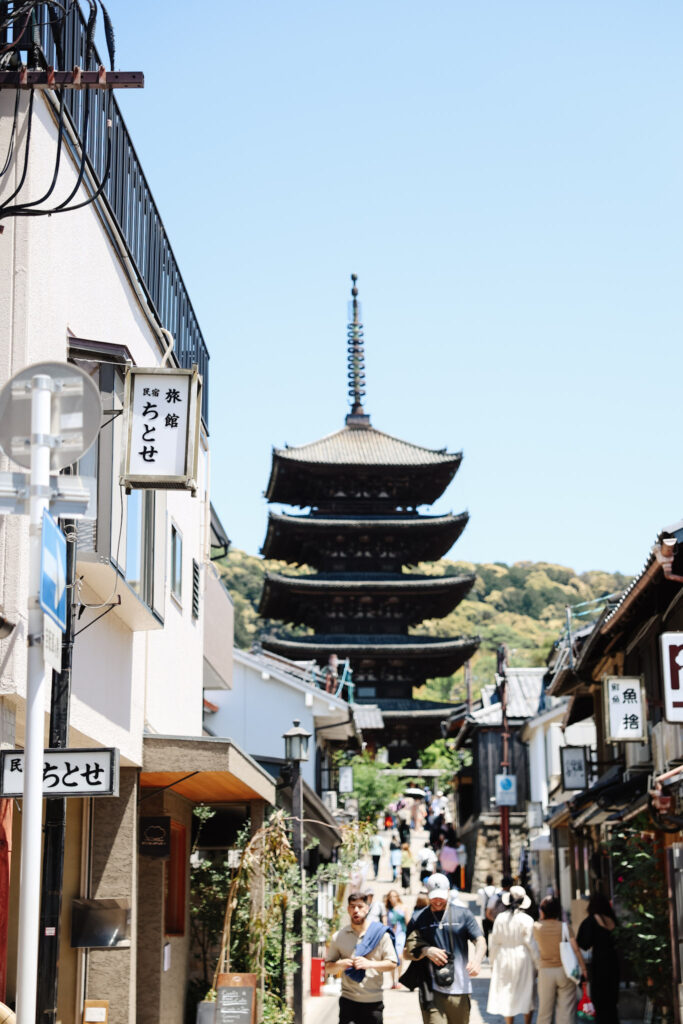
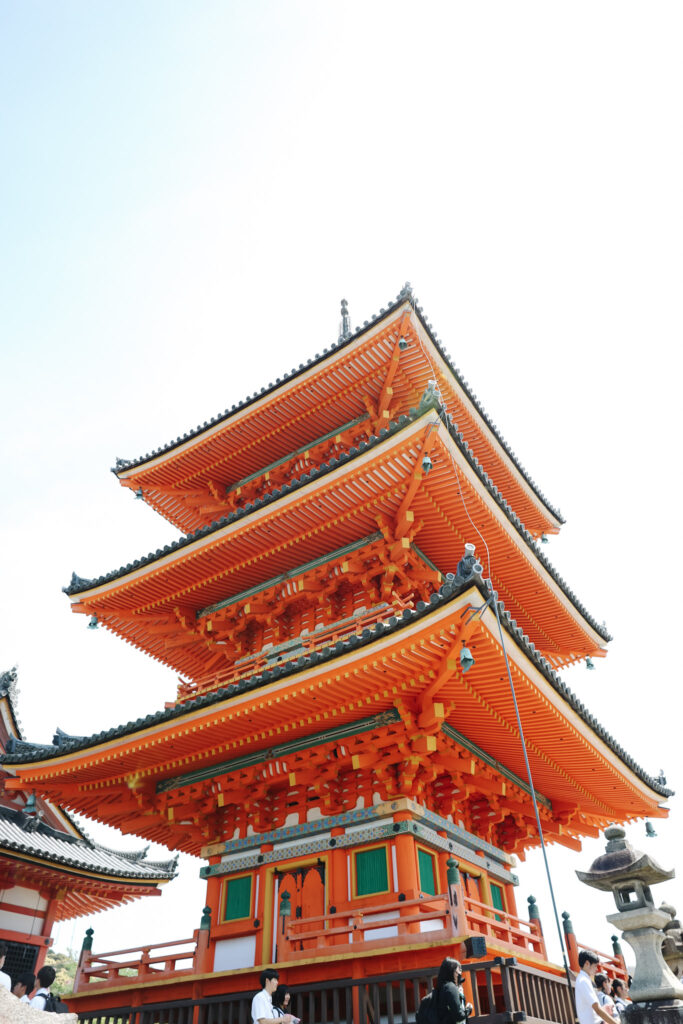
Once we finished at the temple, we popped into a 7-11 for some lunch items and took the buss over to the Kyoto Gyoen National Garden, which felt like a bit of a breather between temple visits. The paths are wide, with open spaces and shaded trees, making it a nice place to slow down. We loved our stroll here and sitting to eat some lunch.
After that, we swung by the Hyatt to grab our backpacks that had all our stuff for the next couple days, which we’d left earlier in the day to keep things light. Our final sightseeing stop for the day was a return to Nijo Castle, which was open this time! We loved finding the “nightingale floors” that chirp as you walk and seeing all the gorgeous wall decorations and loved learning its history during the Edo period. It’s incredibly well-preserved and marks a really important time in Japan’s history, so we loved being able to see this. The castle grounds are also beautiful and spacious, with moats, gates, and ornamental gardens to explore. You can book a Nijo-jo Castle and Ninomaru Palace guided tour here.
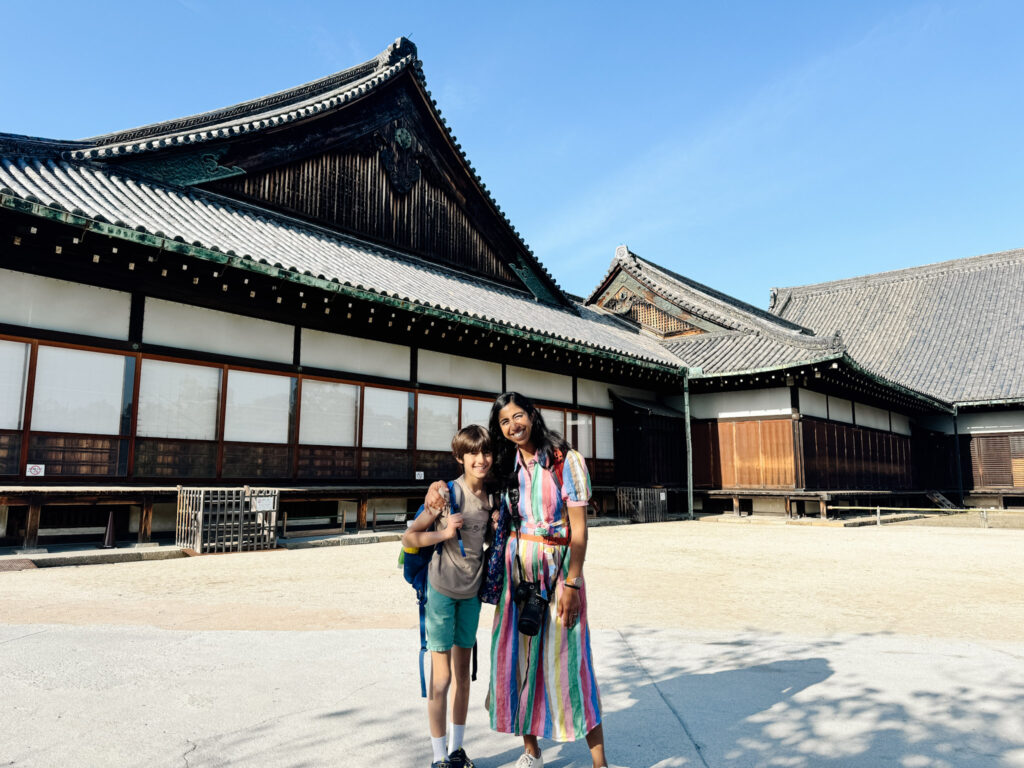
After the castle, we took a quick subway ride, where we (eventually) got picked up and driven to our ryokan. There was a misunderstanding with the exact pickup location and they unfortunately never tried to contact us or respond to emails, and didn’t have a WhatsApp number for me to call. I finally asked a very kind local mom to call them on my behalf and they came back and got us. Dinner at the ryokan was a traditional multi-course meal, beautifully presented and fun to try each one. They did make a vegetarian meal for us, which we appreciated. We ended the evening with a soak in the onsen, which was the perfect way to unwind. We booked the private onsen so T and I could go together, and it was nice, if a bit small. The rooms were also comfortable with beautiful views, if a bit dated. Overall, this was a lovely experience that I would definitely recommend if you’re looking for a ryokan stay near Kyoto. That said, it was our priciest night and was similar to (but not as good as) our monastery stay the next night, so if you have the time and ambition to go all the way up to Koya (explained further down), this ryokan is a good option.

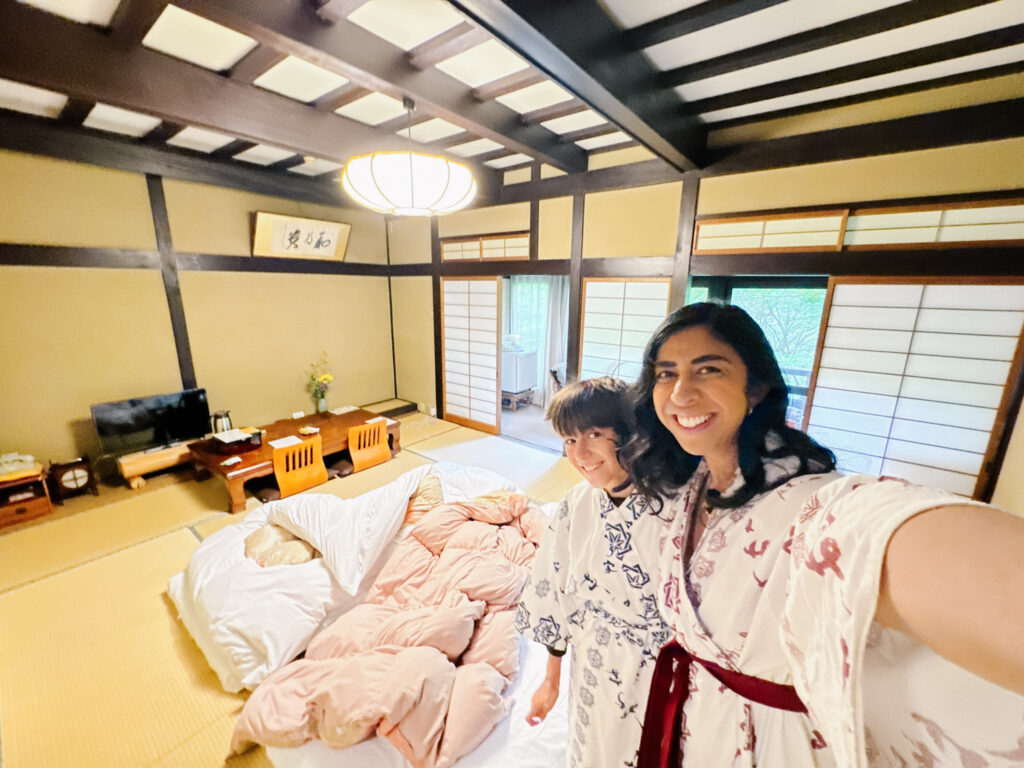
Day 7: 3 Days Itinerary in Kyoto
- Breakfast at ryokan
- Ninna-ji temple
- Kinkakuji temple + goshuin
- Travel to Koyasan to Daienin monastery
- Dinner & onsen at monastery
We began the day with breakfast at our ryokan, which was another lovely traditional spread—simple but filling, and such a nice start to the morning. Our first stop was Ninna-ji Temple, which we only visited because that’s where the ryokan shuttle could drop us that was closest to our next stop. But this turned out to be a real hidden gem – it was beautiful and not crowded at all! There were clearly only a few locals there and it was peaceful and lovely. It looked like it was a popular place for locals to come during sakura season (which we’d missed a few weeks prior) but was super lovely to walk around. The grounds were huge and there were several interesting shrines to see. We loved this spot!
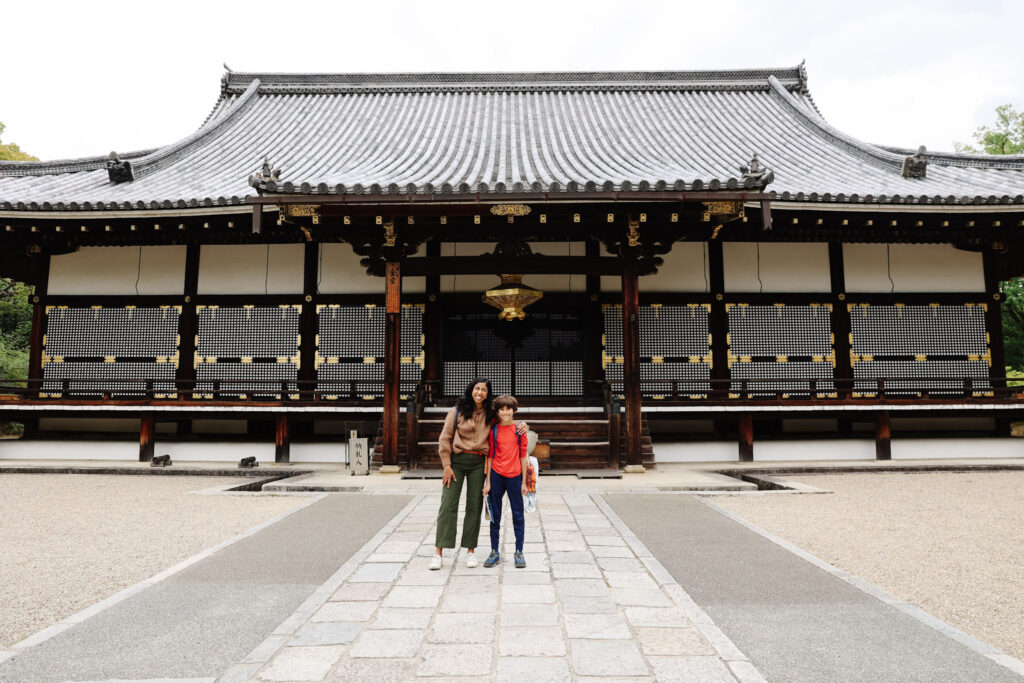
Next, we took the city bus over to Kinkaku-ji, the famous Golden Pavilion, which looked absolutely stunning shining in the sunlight. It was much busier than Ninna-ji but still felt worth the visit. It’s a tricker place to get to that takes surprisingly long from the center of the city, but definitely worthwhile. We also picked up a goshuin (temple stamp) here.

The rest of the day was spent making our way up to Koyasan, which was a long journey but also incredibly scenic, winding through mountains and smaller towns. We took a bus from Kinkakuji to a subway station, then the subway to Kyoto station, the train to Osaka, the city JR line in Osaka, another train and a transfer to yet another train to Gokurakubashi, then a cable car up to Koya, and the city bus to the monastery where we were staying. Whew! The whole journey took about 3.5-4 hours.
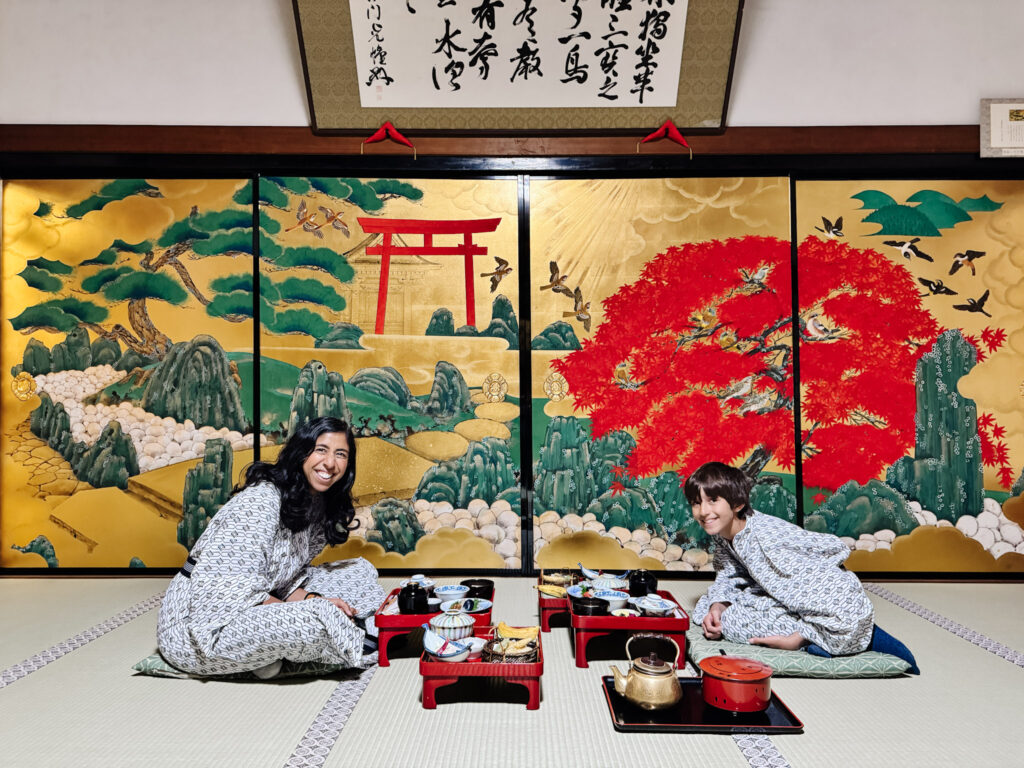
We eventually arrived at Daienin, a Buddhist monastery where we stayed the night. It was absolutely magical and beautiful to be able to do this and completely worth every step of the long journey to get there. Dinner was a beautifully prepared vegetarian shojin ryori meal; since the Buddhist monks do not eat any animal products, we didn’t need to make any special requests. We thought this meal was absolutely amazing and so flavorful, and the setting was gorgeous. The dining area was downstairs from our room and each “dining room” was covered in the most stunning wall coverings that I could not get over., and we had another relaxing soak in the onsen before settling in for a peaceful night.

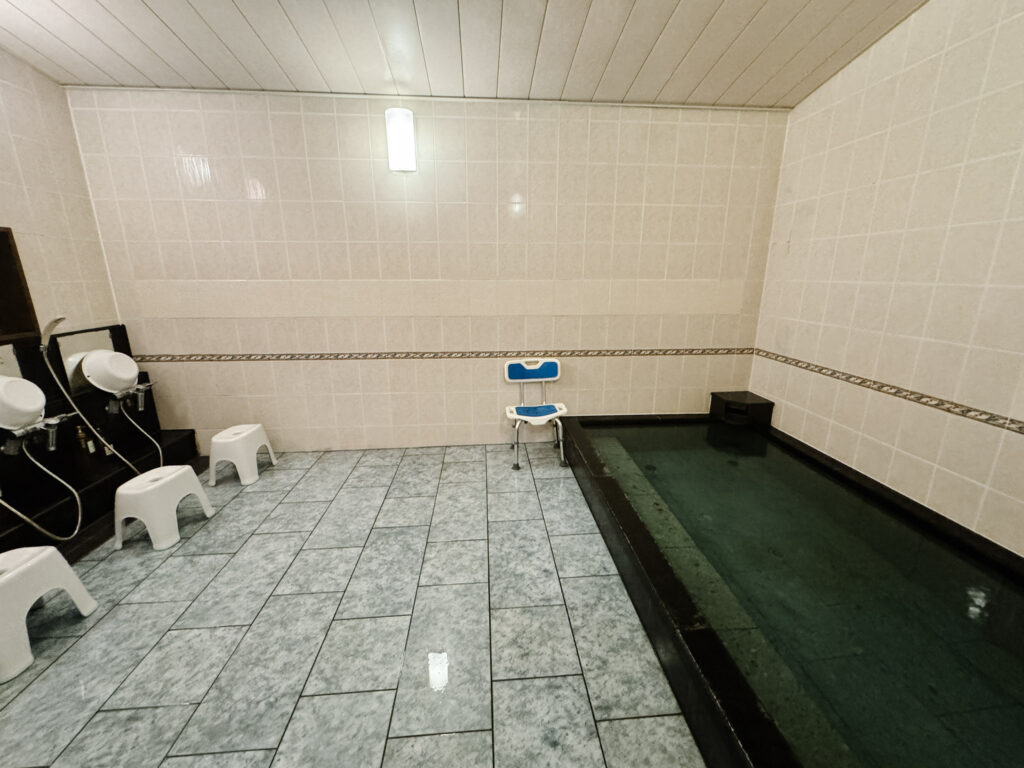
Day 8: Koyasan, Osaka, & Travel Home
- Explore Koyasan
- Kongobuji temple
- Danjo Garan temple
- Koyasan Reihokan Museum
- Okunoin Cemetery walk to mausoleum
- Bus/cable car/train back to Osaka
- Dinner, boba & shopping
- Osaka airport to fly home
We spent the morning exploring Koyasan, a beautiful and serene mountaintop town filled with temples and centuries of history. Our first stop was Kongobuji Temple, the head temple of Shingon Buddhism. The interior was quiet and lovely, with sliding screen paintings and tatami floors, and the rock garden out back was especially impressive. Next, we wandered through Danjo Garan, a striking temple complex with bright red pagodas and sacred halls set among tall cedar trees that is the primary site in Shingon Esoteric Buddhism. There are SO many shrines in Koyasan, but we loved being able to see a couple of these special ones.
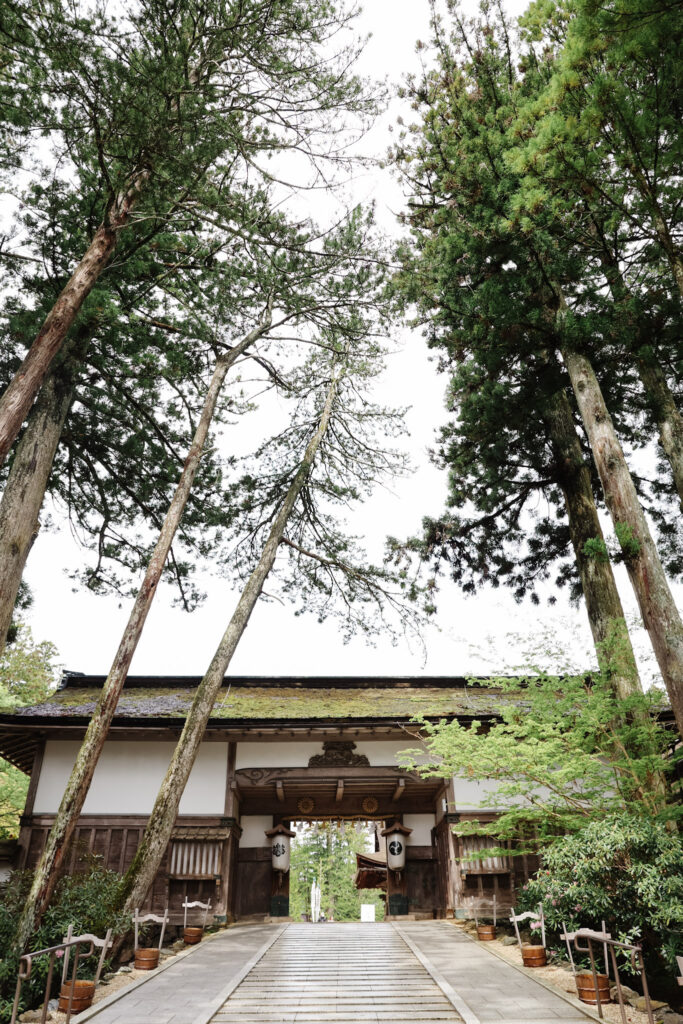

We visited the Koyasan Reihokan Museum, which holds an incredible collection of Buddhist art and artifacts. It’s not a huge museum, but houses some important religious works of art that we loved seeing. We especially loved the mandala paintings.
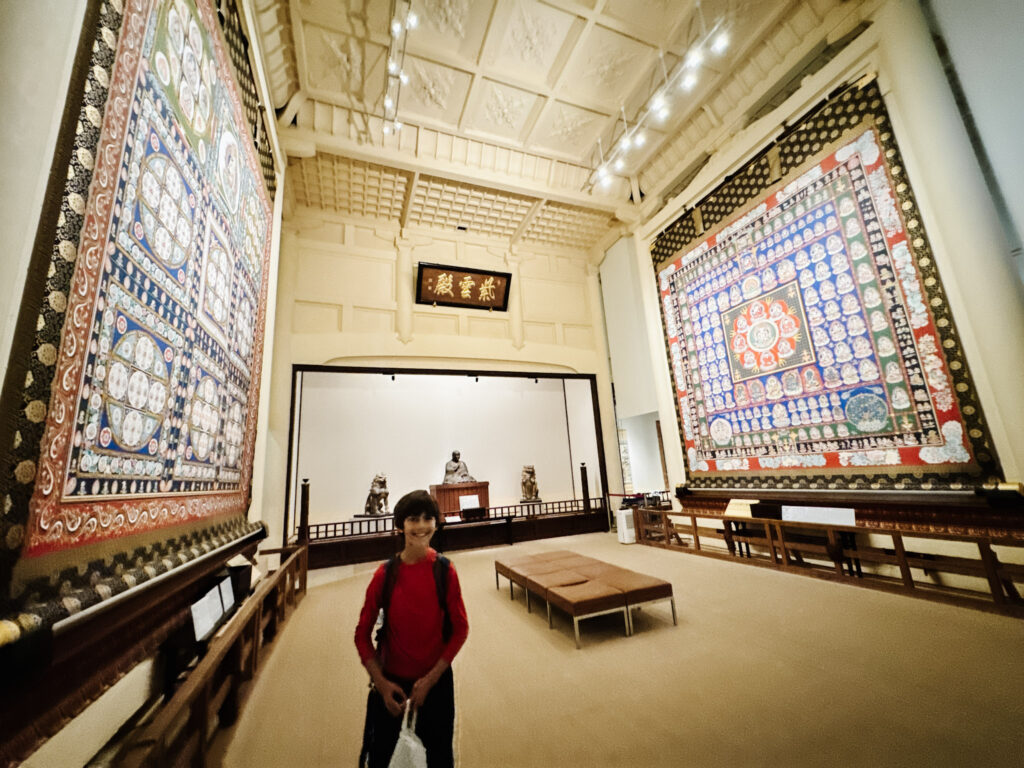
From there, we made our way to Okunoin Cemetery for a walk to the mausoleum of Kobo Daishi who was the leader of Shingon Buddhism. The forested path lined with thousands of mossy gravestones was beautiful and peaceful, with stone lanterns and towering trees. This was such a beautiful and special walk and a perfect capstone to our time in Koyasan. There was also a section where you could go down a row of deities and wash them with a a ladle in a tub of water in front that we loved participating in. We had thought it looked special and neat at the Kiyomizu-dera temple in Kyoto, but the line there was long and it was super crowded, so it was special to be able to do this with hardly anyone else around.
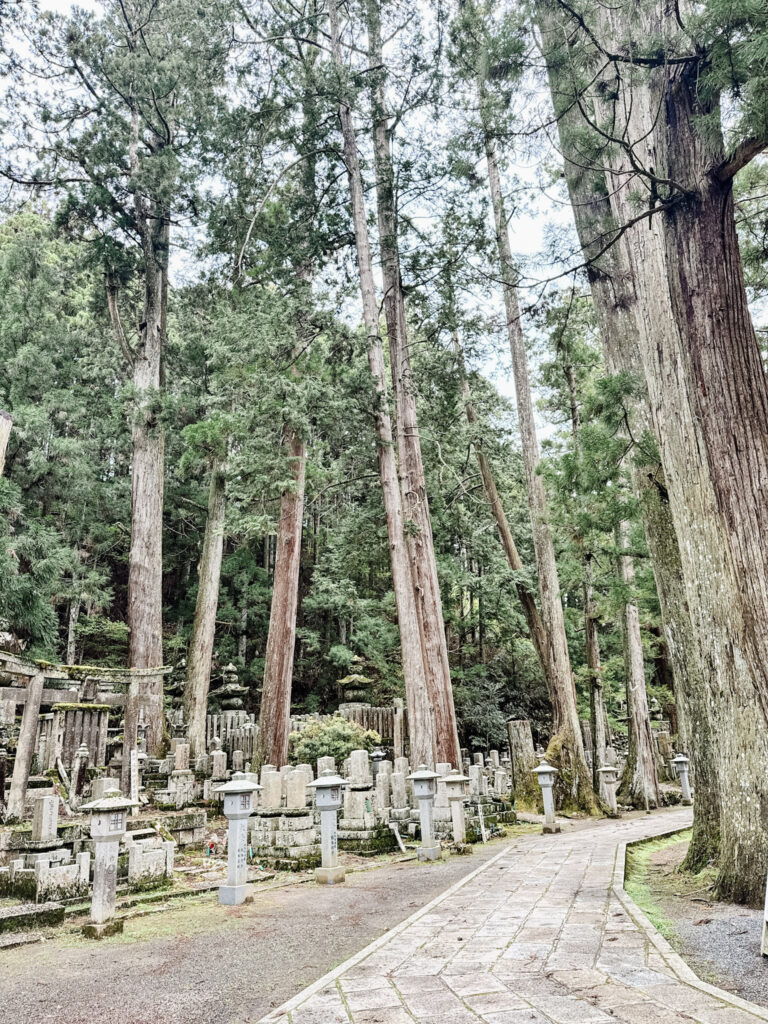
In the early afternoon, we began the journey back to Osaka via bus, cable car, and train, which took a while but gave us one last scenic ride through the countryside. Back in Osaka, we headed to the Dotonbori district near Namba Station, which was convenient both in terms of coming from Koyasan and also because there were several vegetarian food places we thought would be fun to try there. It turns out we only made it to one (one wasn’t quite open yet, and the okonomiyaki place we wanted to try had a super long line), but it was absolutely delicious so we were very pleased. (We ate at Pivot Base and everything we had was delicious, though the spicy ramen was our fave.) We wandered through the market area before getting some boba at Mixue (which we’d recently found out is the largest fast food chain in the world and T wanted to try it out and it was conveniently close to us).
As we were walking, we saw a store with a bunch of Kit Kat flavors dispalyed outside. We’d heard of all the fun Kit Kat flavors in Japan but had only found a couple in other shops we’d checked, so we were excited to see 4 or 5 here. We popped inside and found a bunch more, which delighted us, so we bought a bunch to take home to do a taste test with the rest of the fam. Finally, we took the train to Osaka airport, picked up our suitcase (which had happily arrived just fine via the luggage transport service), and flew home via Helsinki.
Overall, it was an absolutely incredible trip that I feel so lucky I got to take with T!
IF YOU LIKED THIS POST ABOUT THE BEST JAPAN ITINERARY, YOU MIGHT LIKE THESE POSTS, TOO:
- Top 10 Must Do London Activities for Families
- Family Travel Packing List
- Best Things to Do in Paris with Kids
- 3 Days in Isle of Skye with Kids
